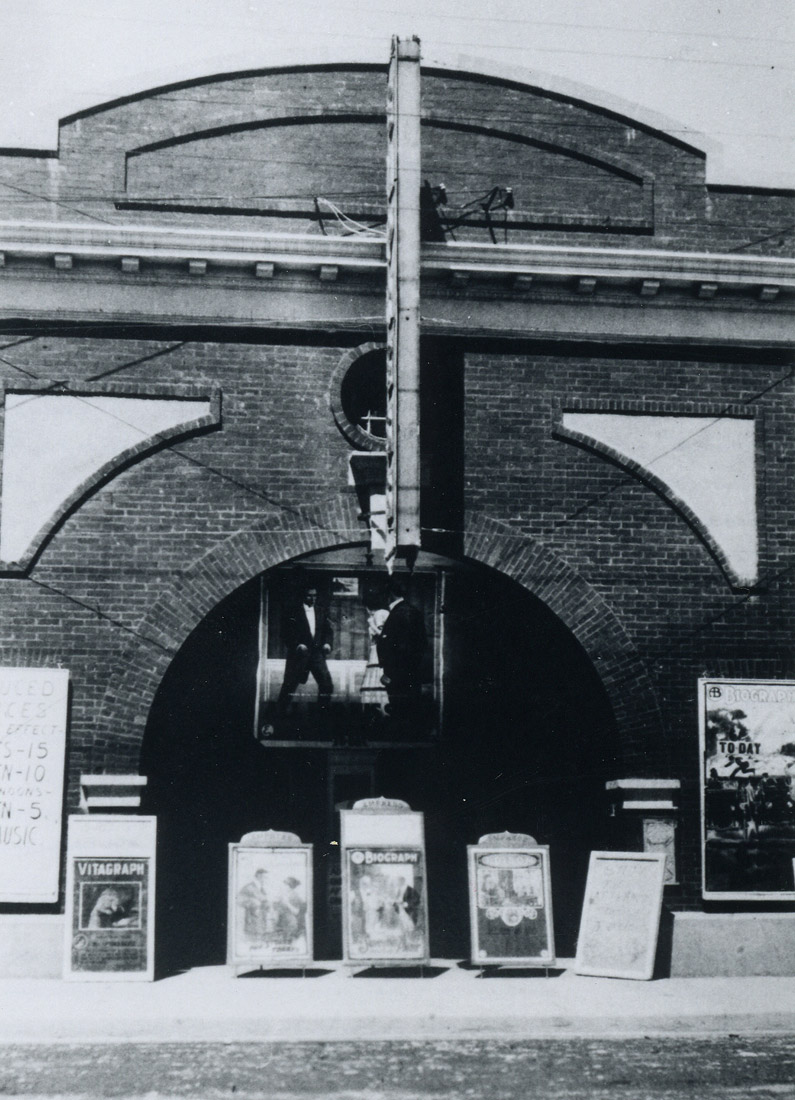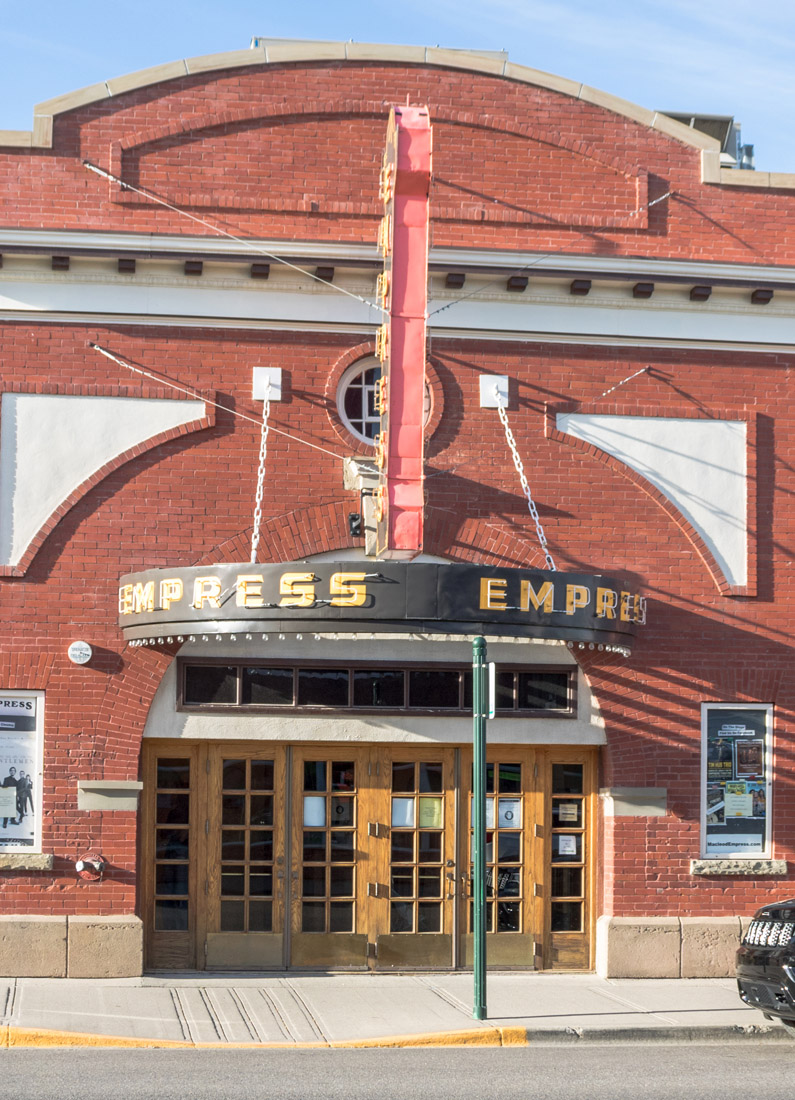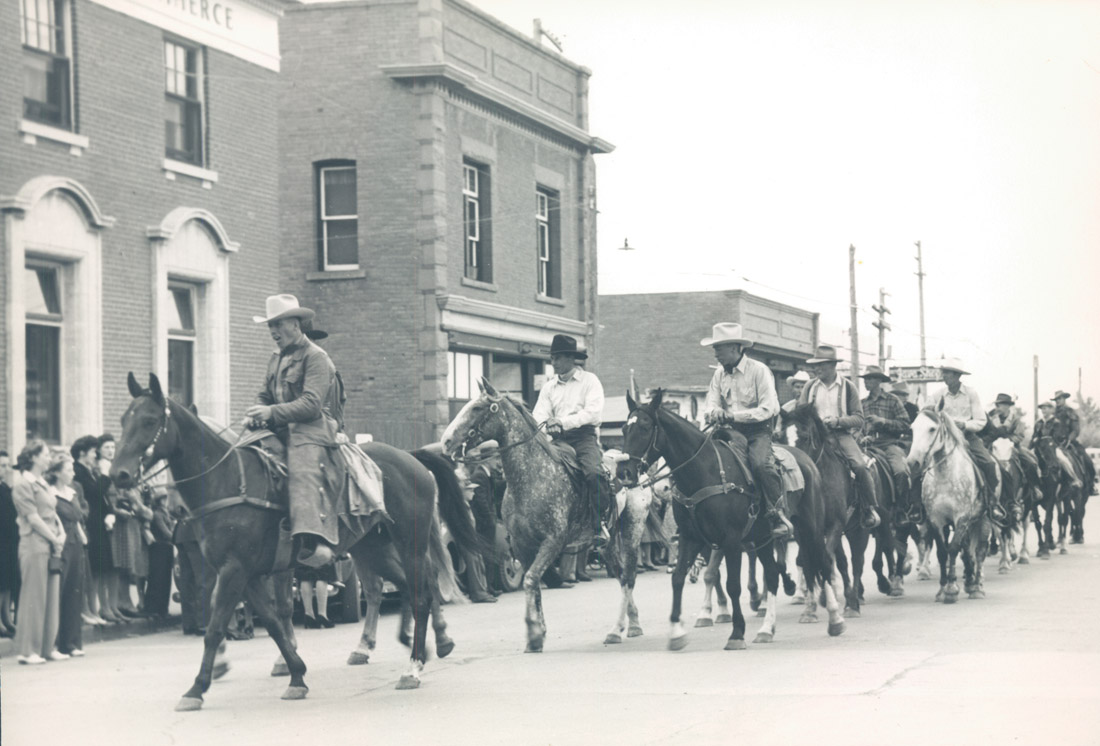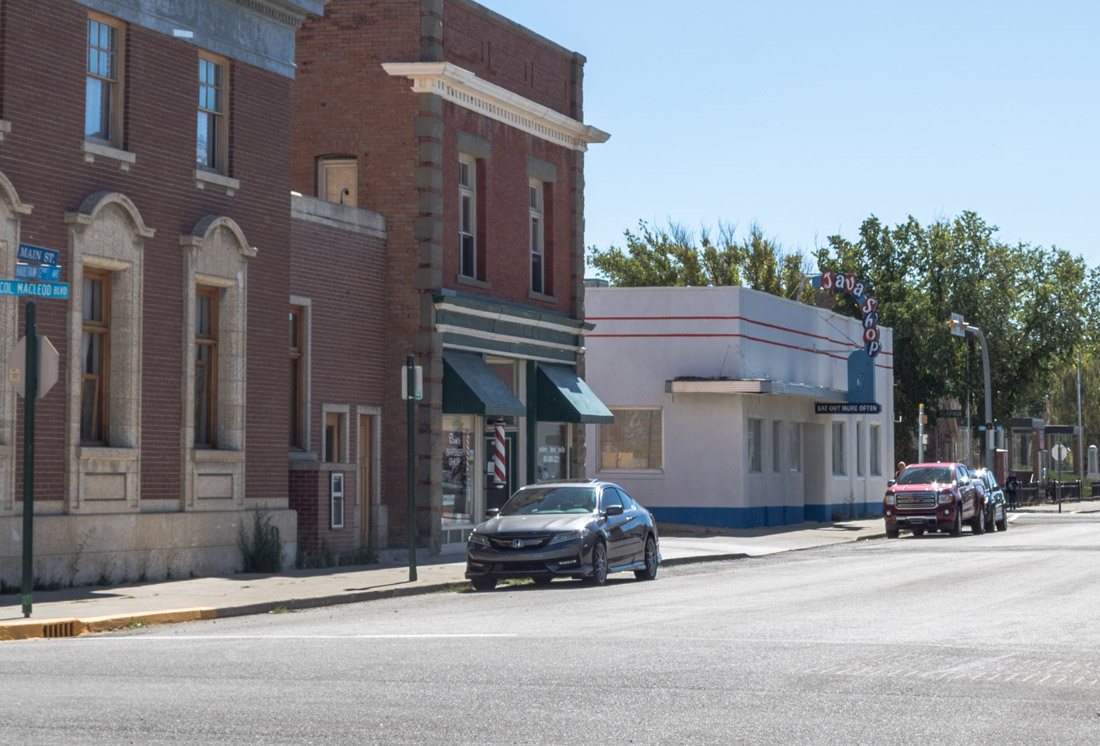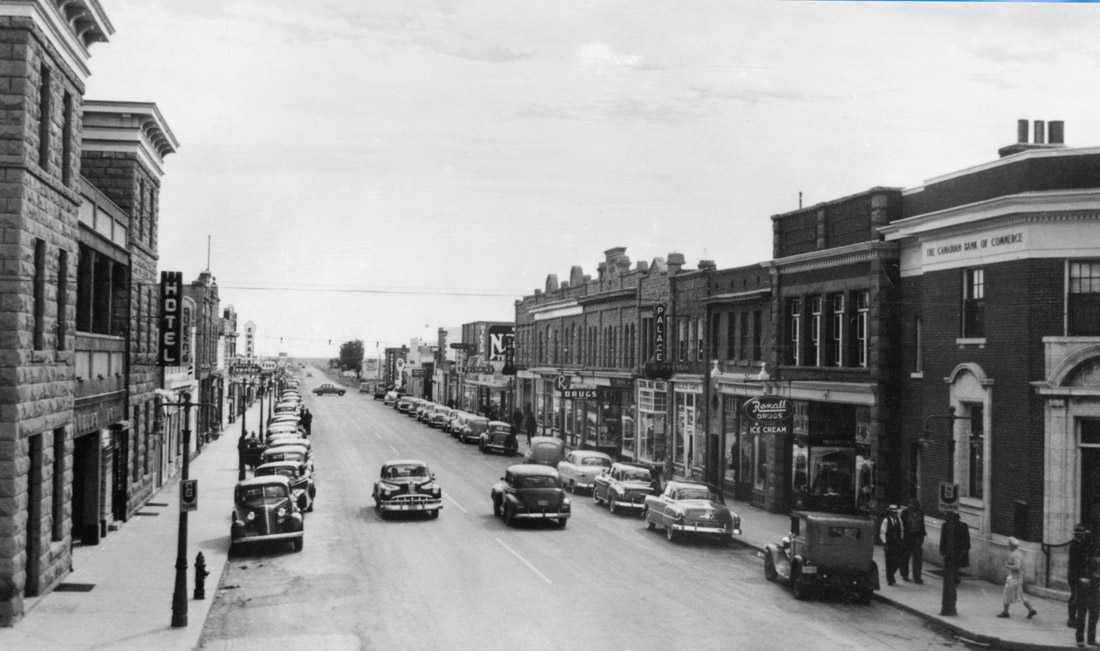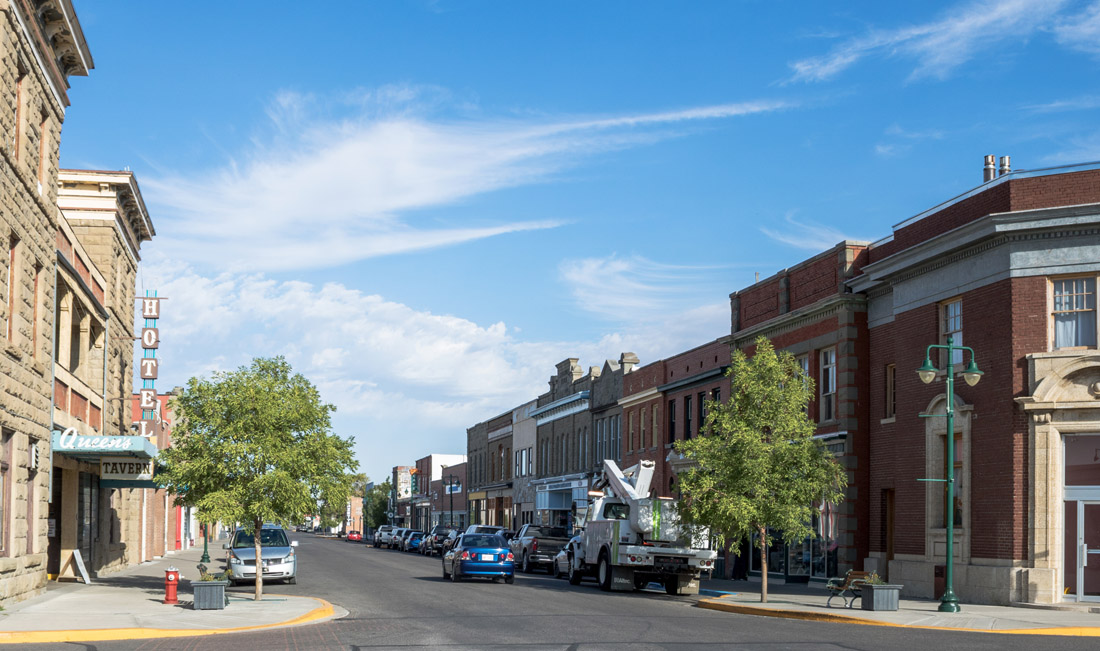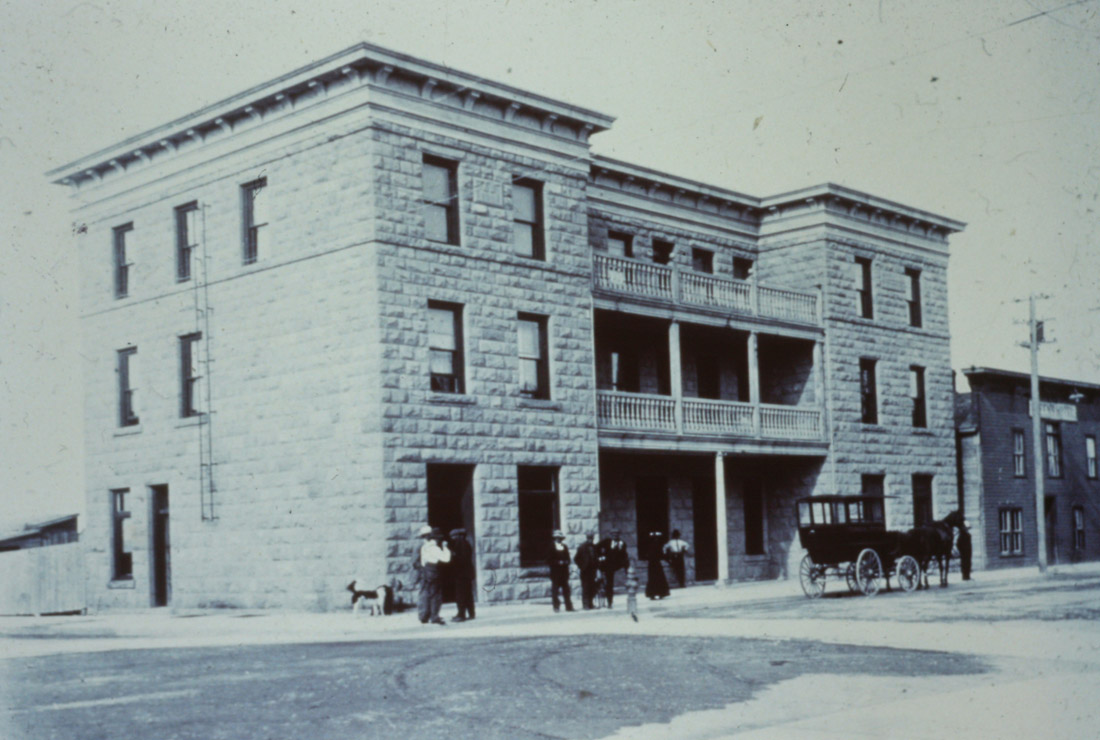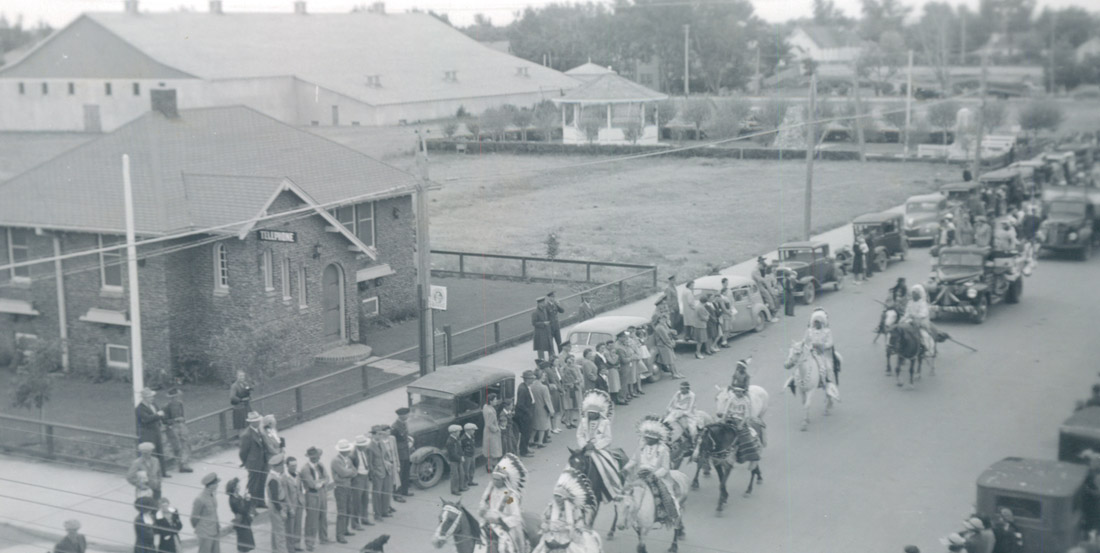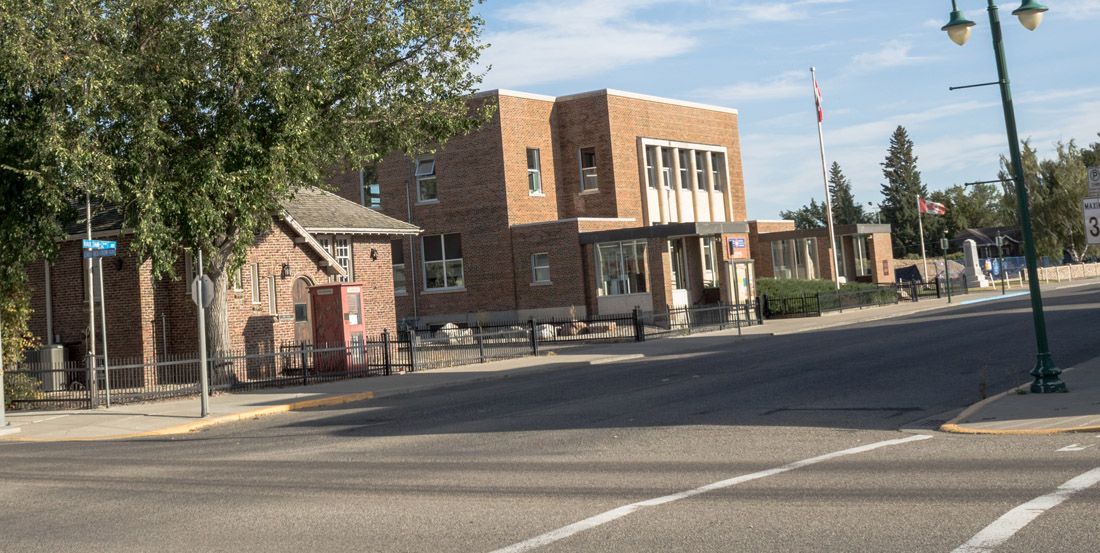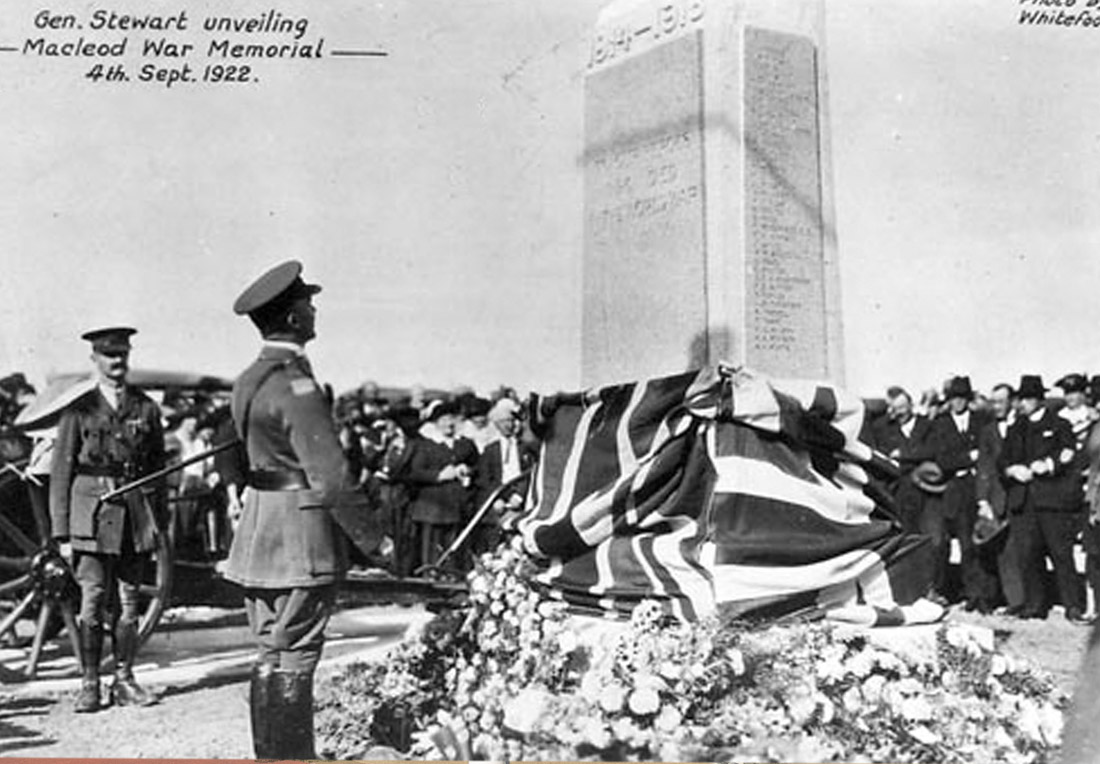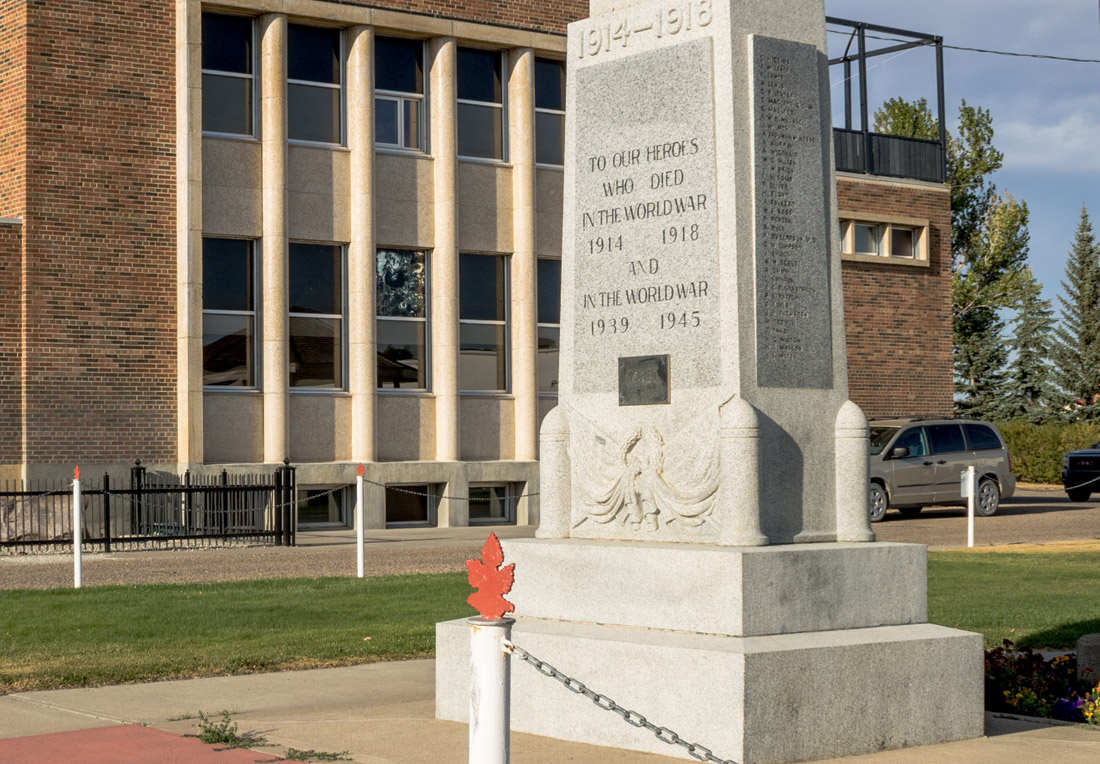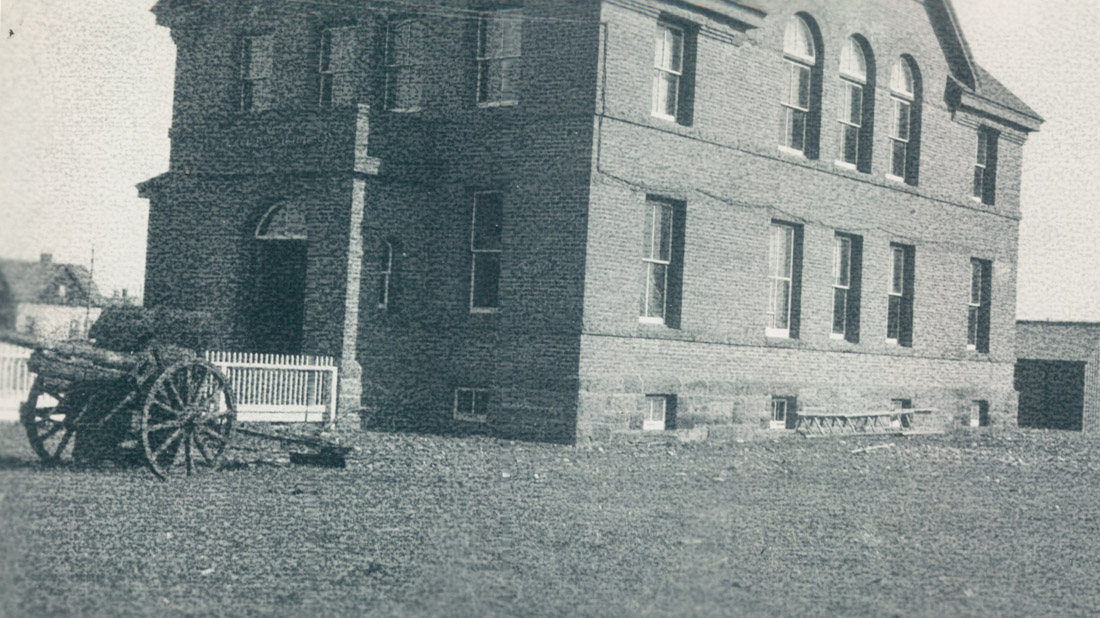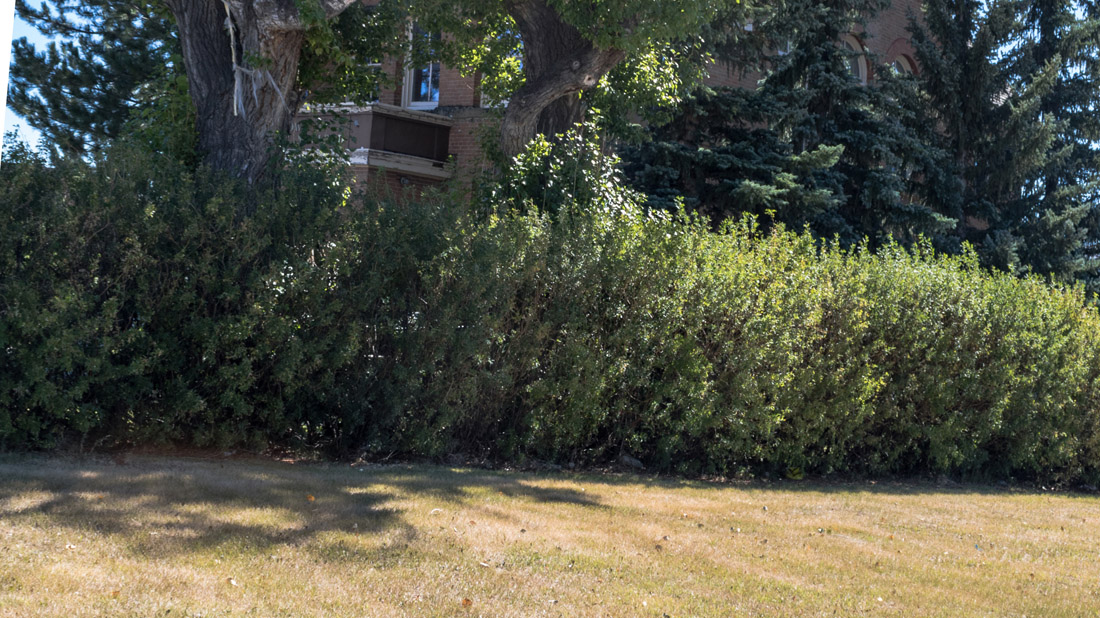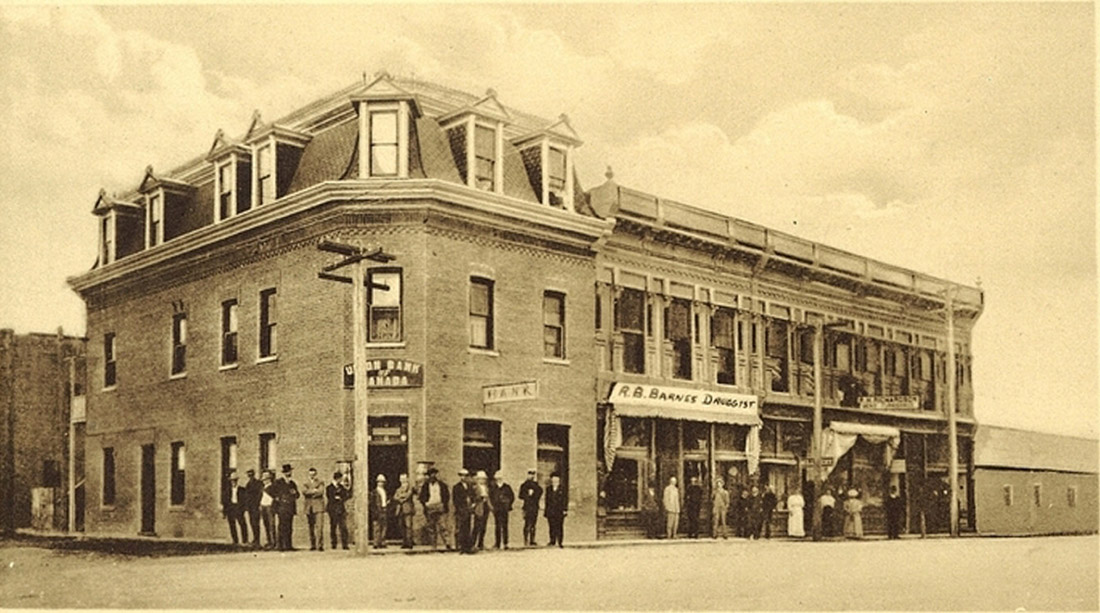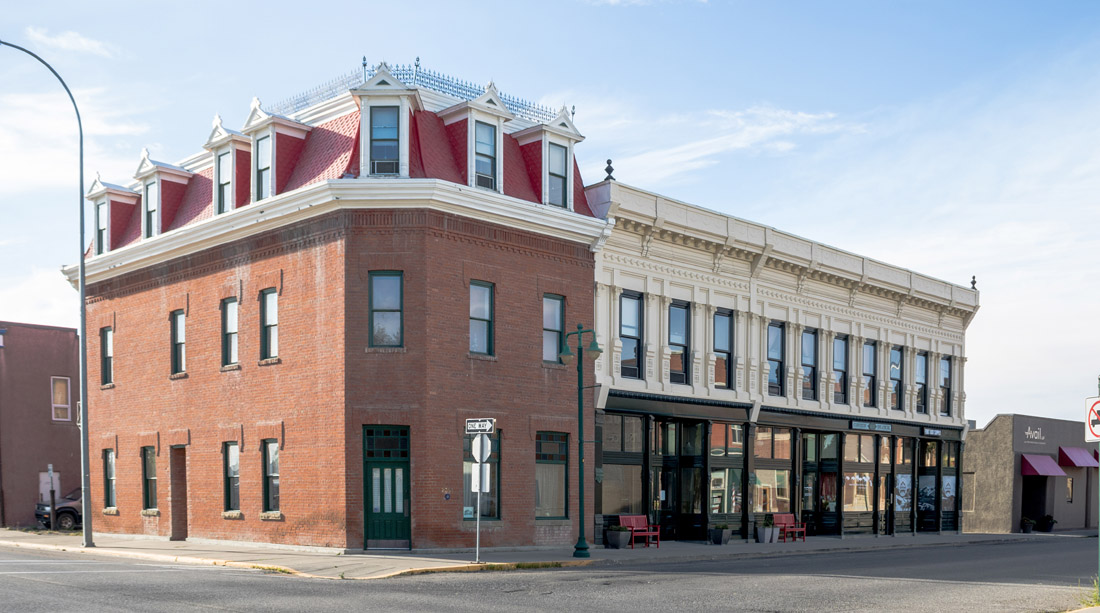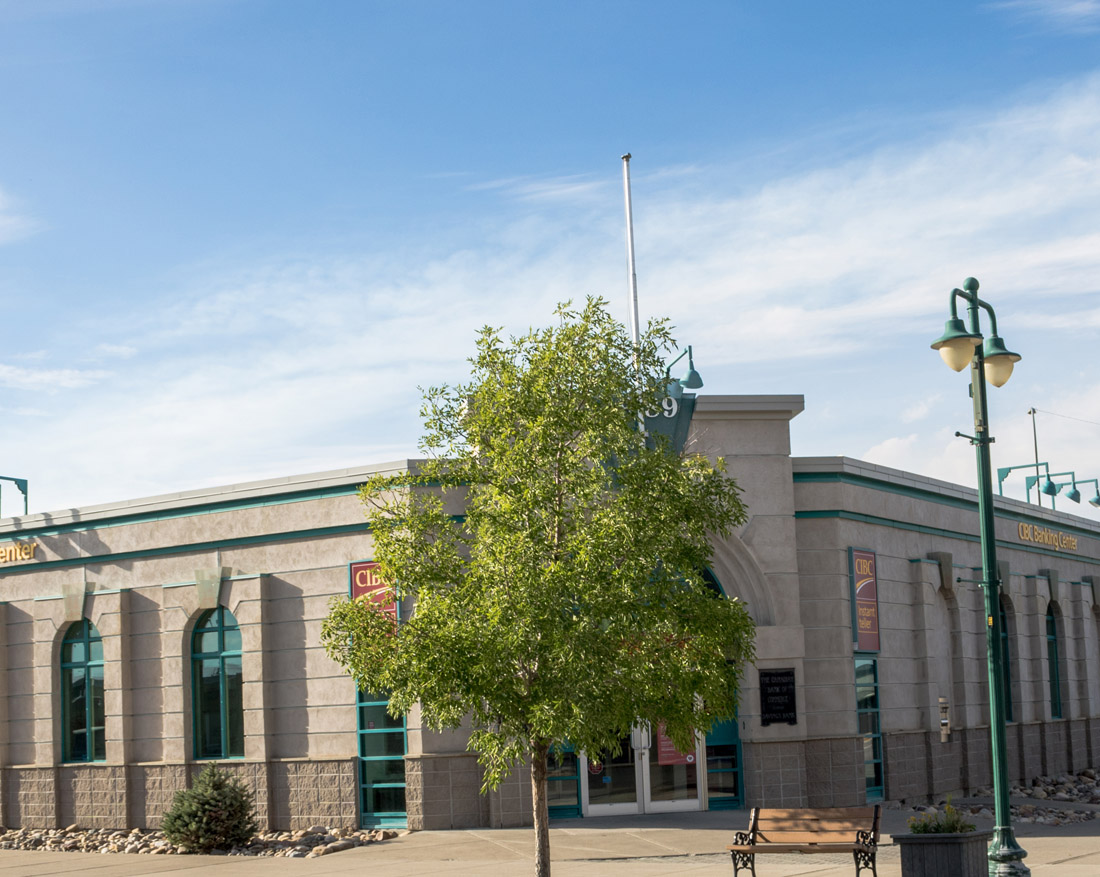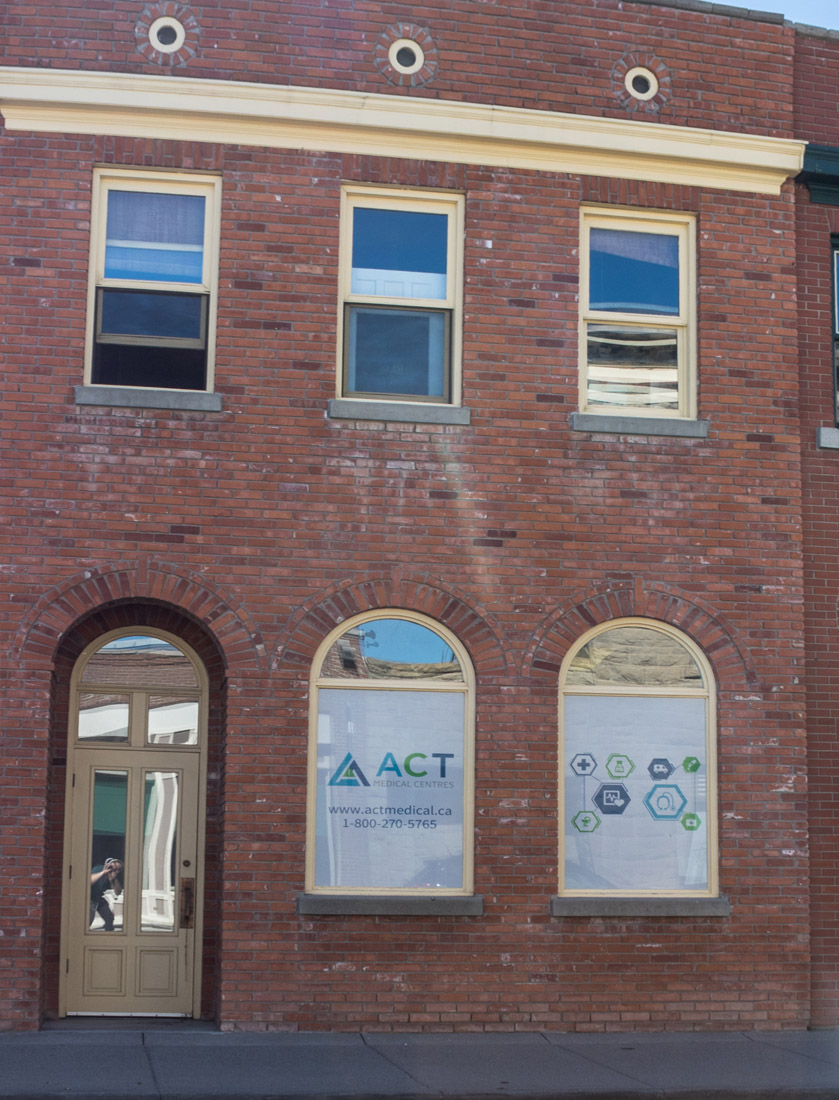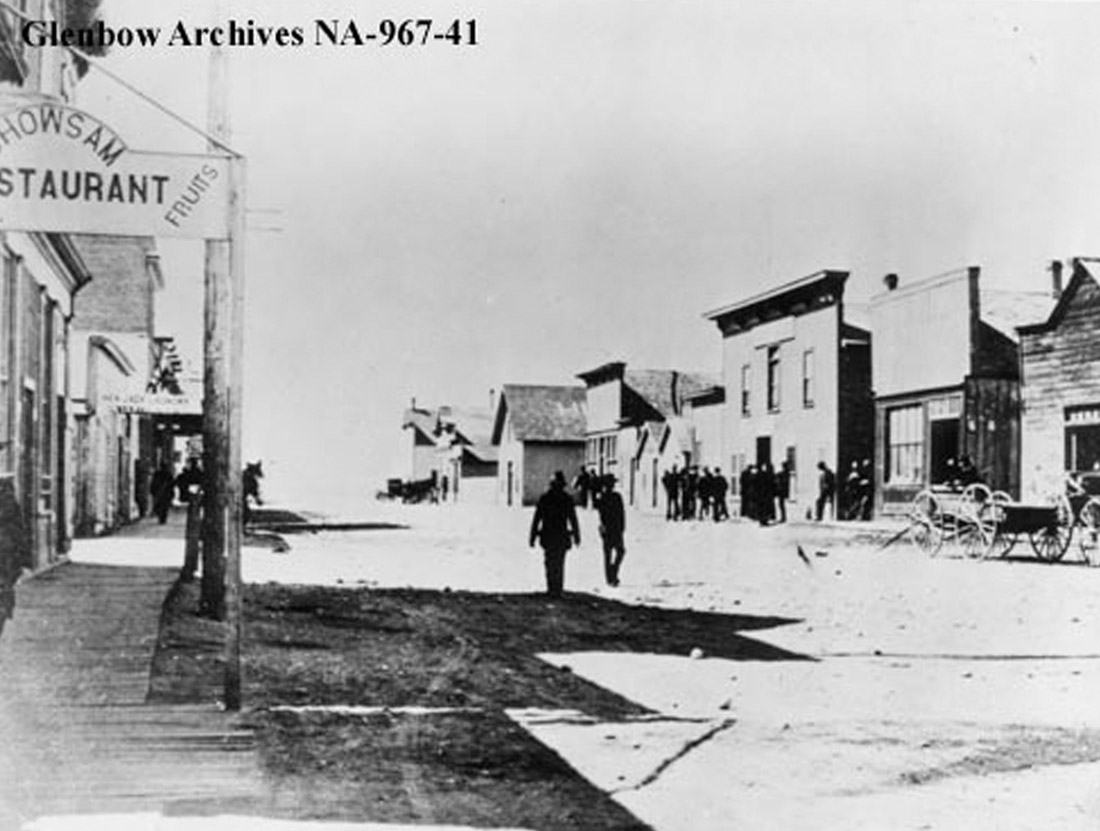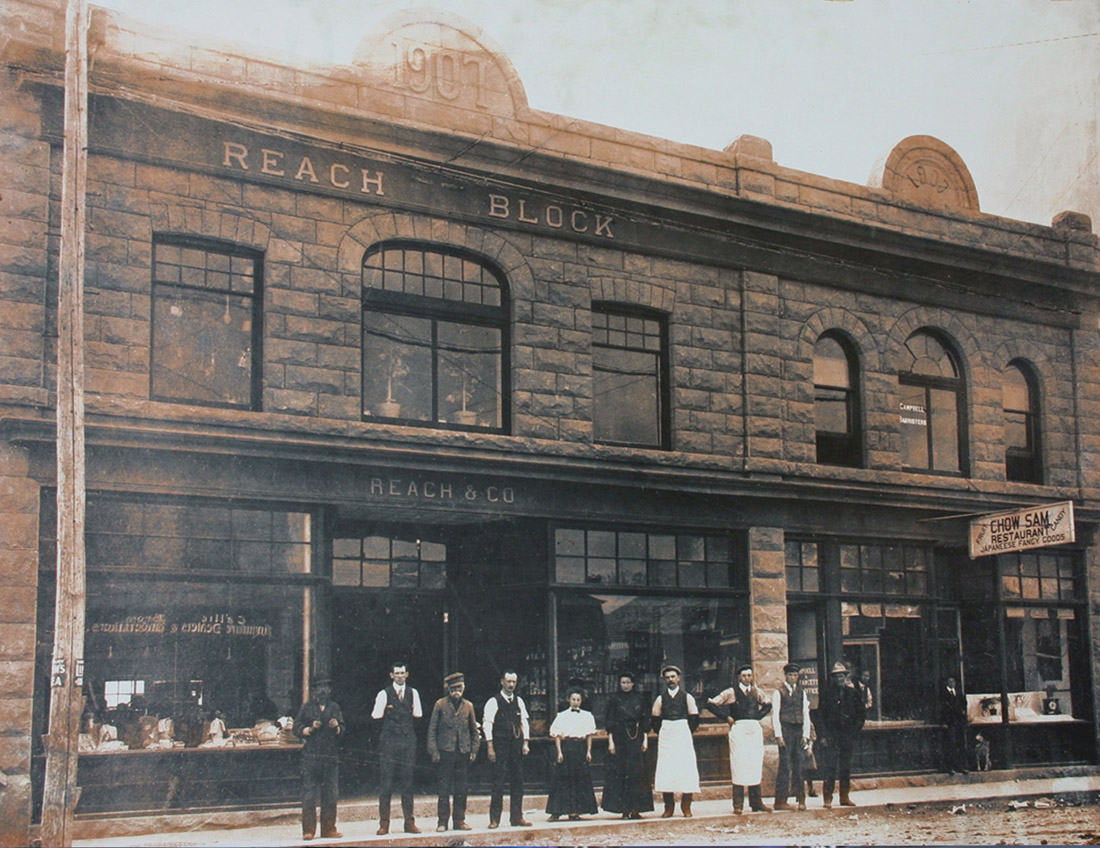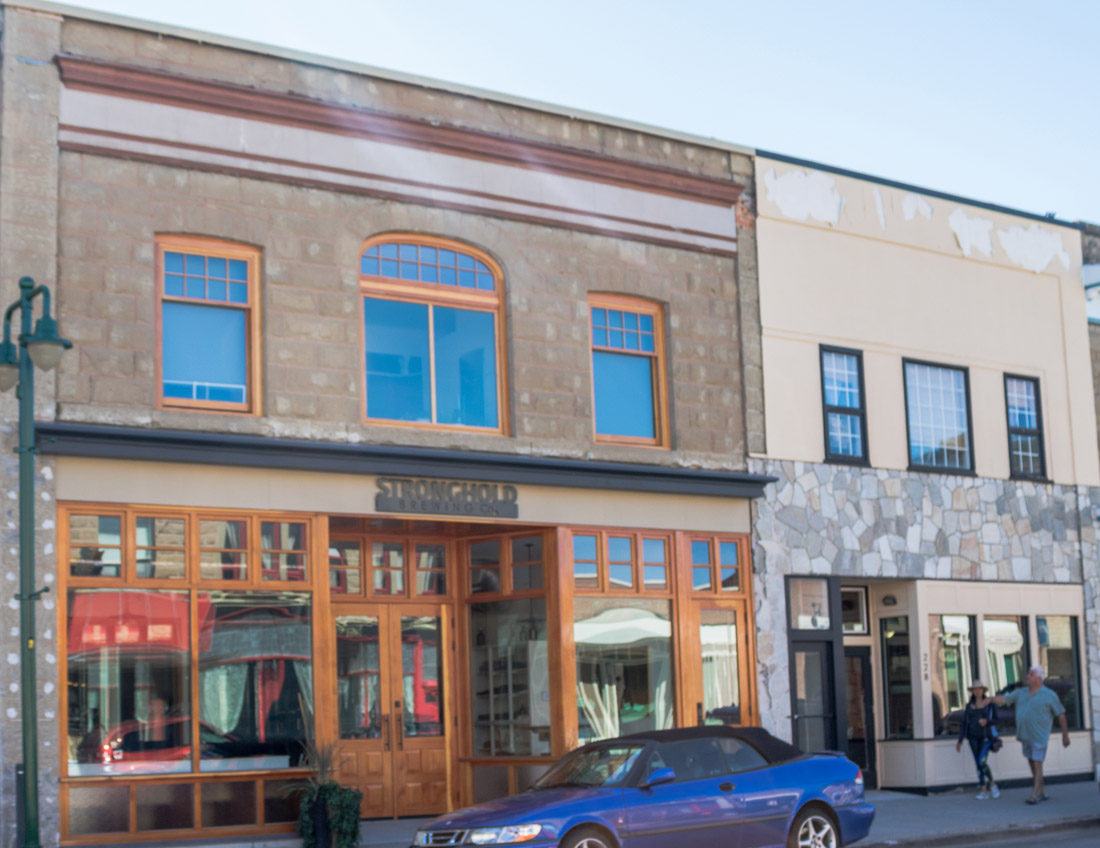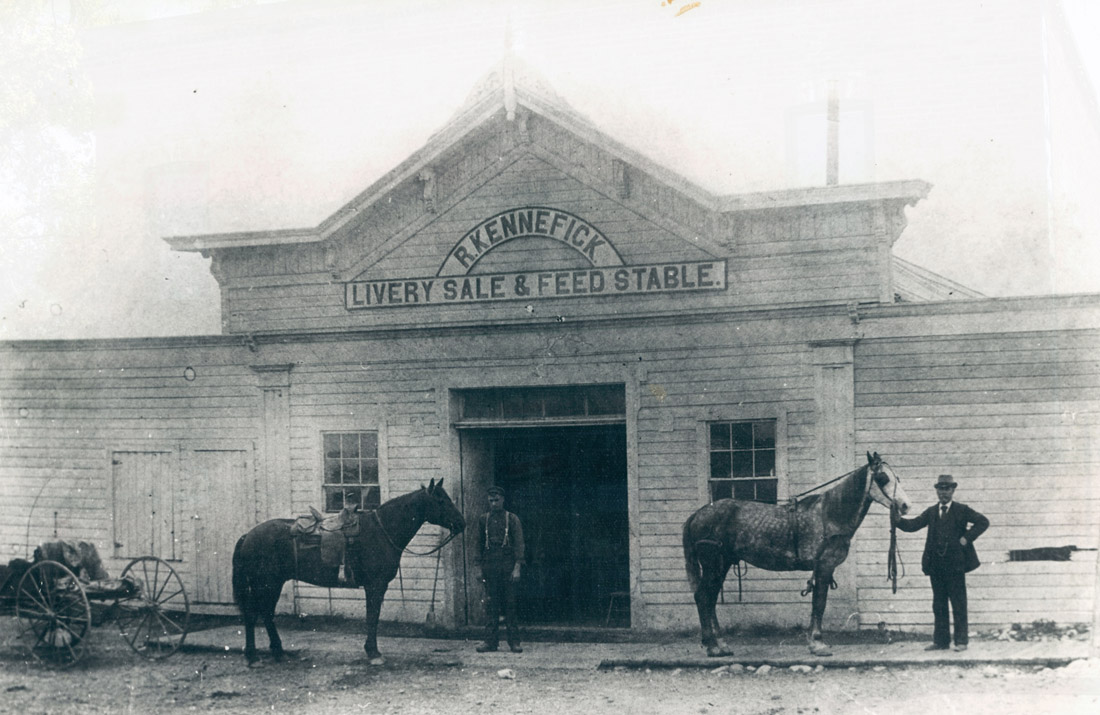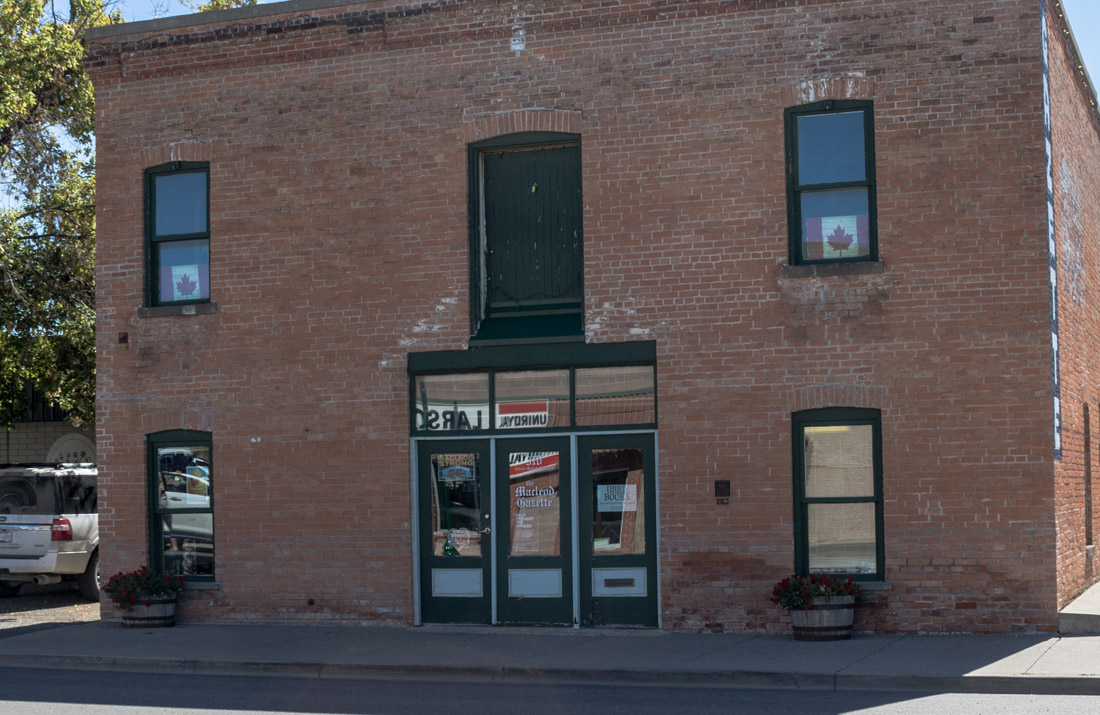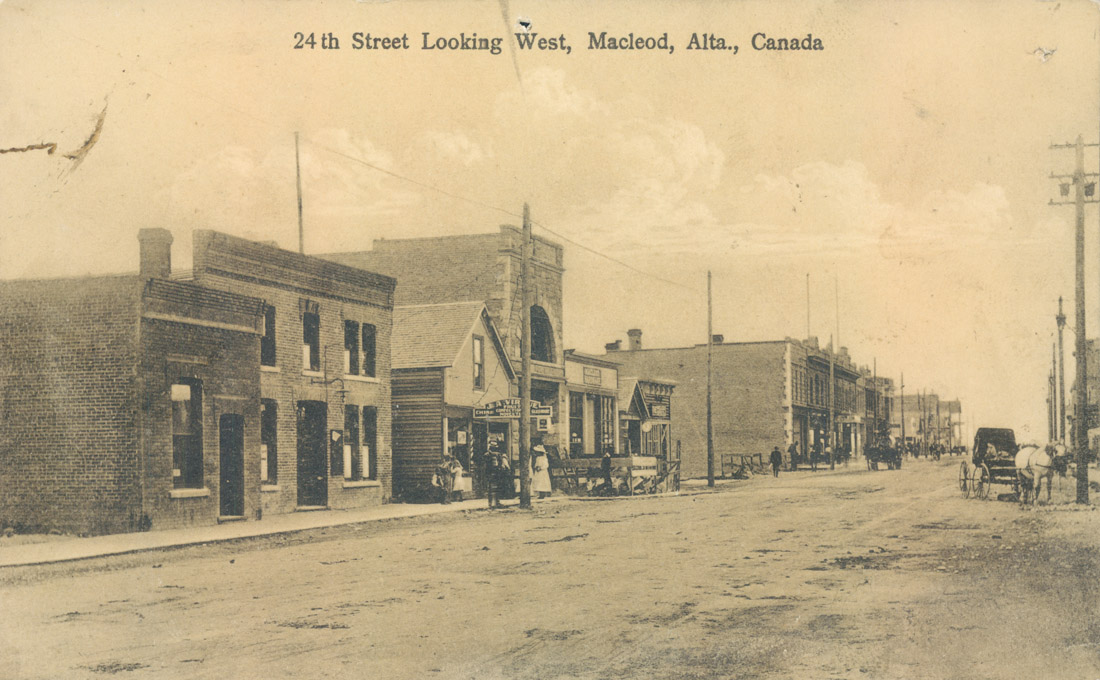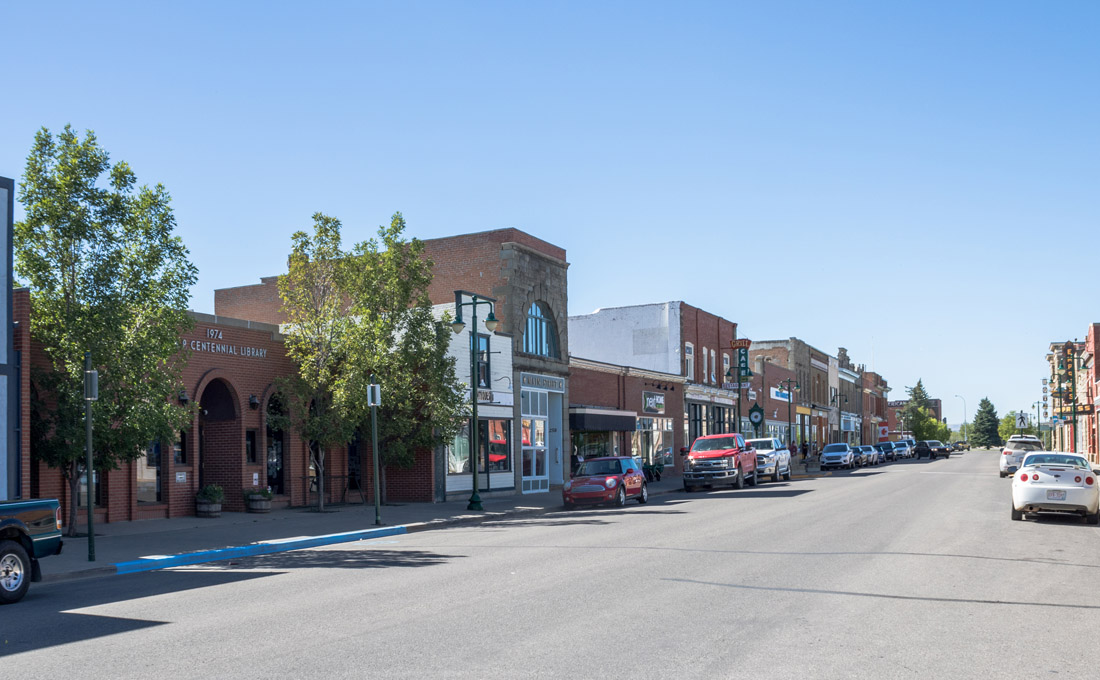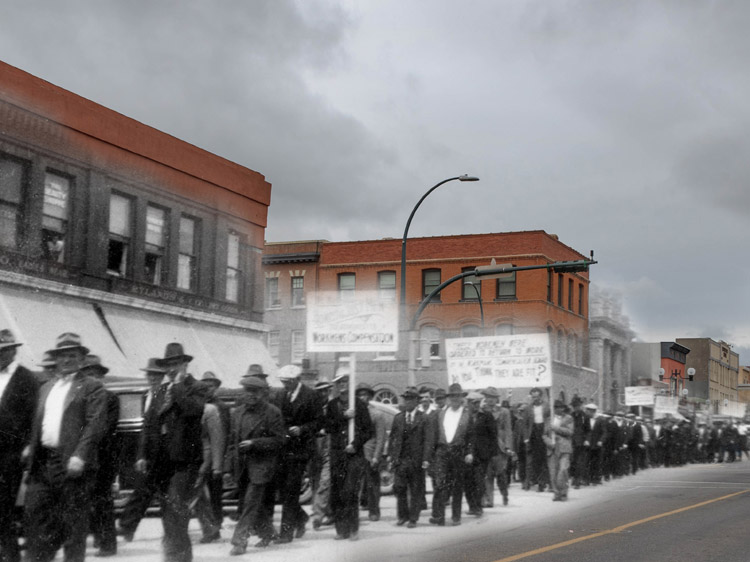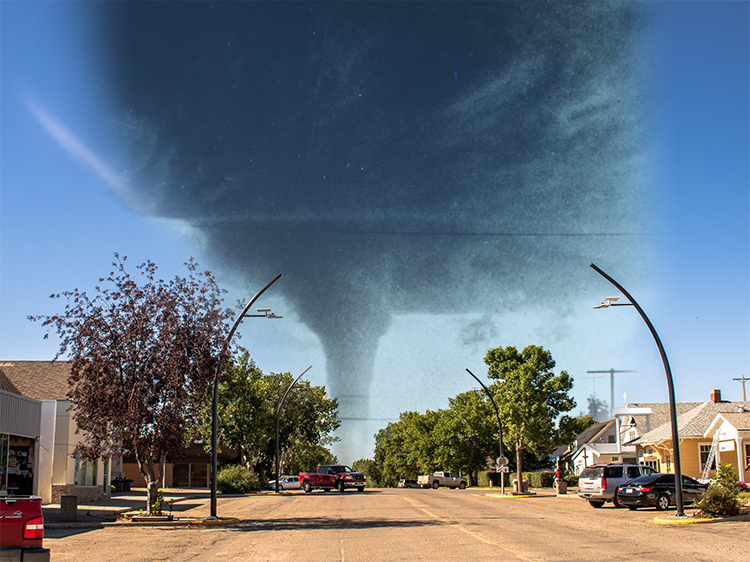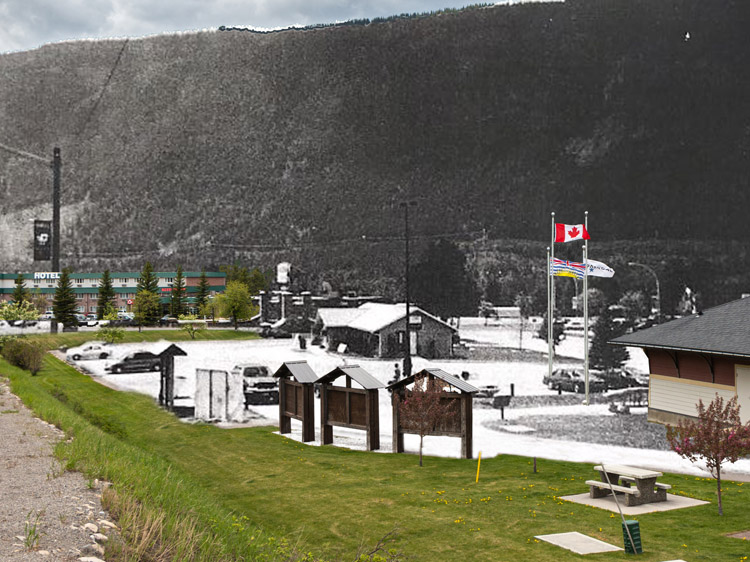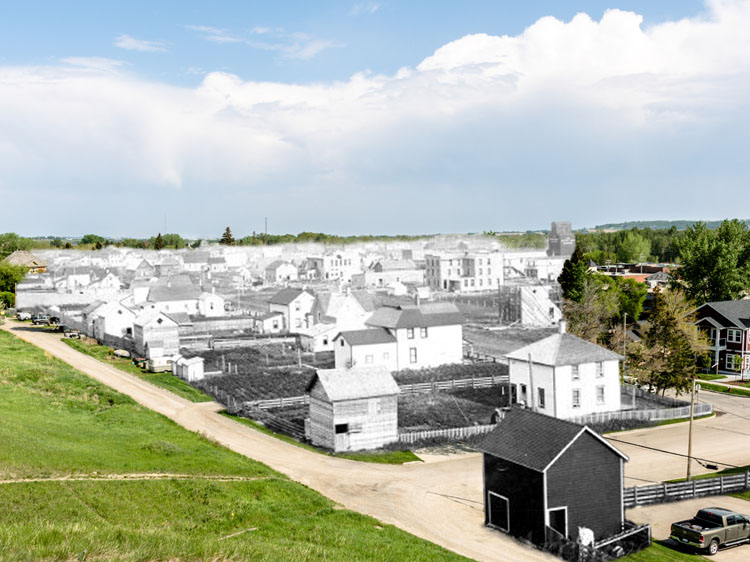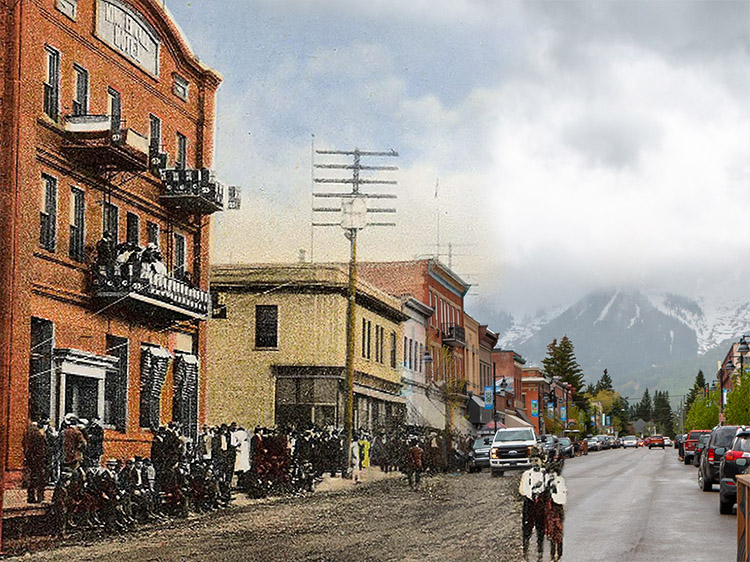Walking Tour
Tales of Main Street
Life, Livelihood, and Leisure in Fort Macleod
Alexa Dagan

This settlement, nestled in the prairie at the base of the foothills of the Rocky Mountains and on the banks of the Old Man River, boasts the natural, austere beauty of the plains of southern Alberta. When one newspaper reported on the geography of the town, it stated that "[Fort Macleod] commands a view which, for variety, beauty, and grandeur, is hard to be excelled… It is the finest section of the North West." First the traditional territory of the Blackfoot Confederation, then a North West Mounted Police fort, to the home of cowboys and ranchers, to its rise as a railway boom town, Fort Macleod has long been home to locals who have survived, failed, and triumphed through the rises and falls of frontier life. Aside from the Holy Cross Catholic Church, this tour focuses on Fort Macleod's heritage businesses, their original proprietors, and buildings located within the designated Provincial Historic Area, one of only two such designated historic areas in the province.
Our tour will start on the south side of 24th Street (the historical Main Street) directly across from the Empress Theatre, the first stop on this tour. After that we’ll head west, to the northwest corner of 2nd Avenue and 24th St to learn about the experiences of the first settlers of Fort Macleod and the early days of the community. Then we’ll continue south, where we’ll see the old Canadian Bank of Commerce building and uncover the history of the heritage buildings framing the intersection. Next, we will go to Fort Macleod’s memorial square to study the monuments and learn about their contributions in the Second World War. From there, we’ll make a stop outside of the historic courthouse - which is the only remaining building in Alberta that served as both a territorial and a provincial courthouse.
After the courthouse, we’ll go back to 2nd Avenue to look at some of the oldest commercial buildings on Main Street. We’ll end the tour by crossing 3rd Avenue to learn about the award-winning Macleod Gazette, then turn north to view the Chow Sam Boardinghouse and the Holy Cross Catholic Church. To complete things, we suggest you return to Main St. to contemplate all you learned about the people who walked these streets over a century ago.
This project is a partnership with the Cultural Heritage Tourism Alliance and Tourism Fort Macleod.
1. Empress to Queens
Late 1920's
This photo, taken in the late 1920s, features the Empress Theatre (built in 1912) and holds the title of the oldest operating theatre in Alberta. After opening, the Empress showed all forms of popular entertainment at the time: vaudeville shows, concerts, live theatre, lectures, and silent films. Looking to the left of the Empress is the Macdonnell block, a two-storey commercial building constructed from sandstone in 1909. While the exterior of the Empress hints at the opulence of the interior, the sturdy simplicity of the Macdonnell building is a prime example of the Edwardian architectural character of many of Fort Macleod's other important heritage buildings.
* * *
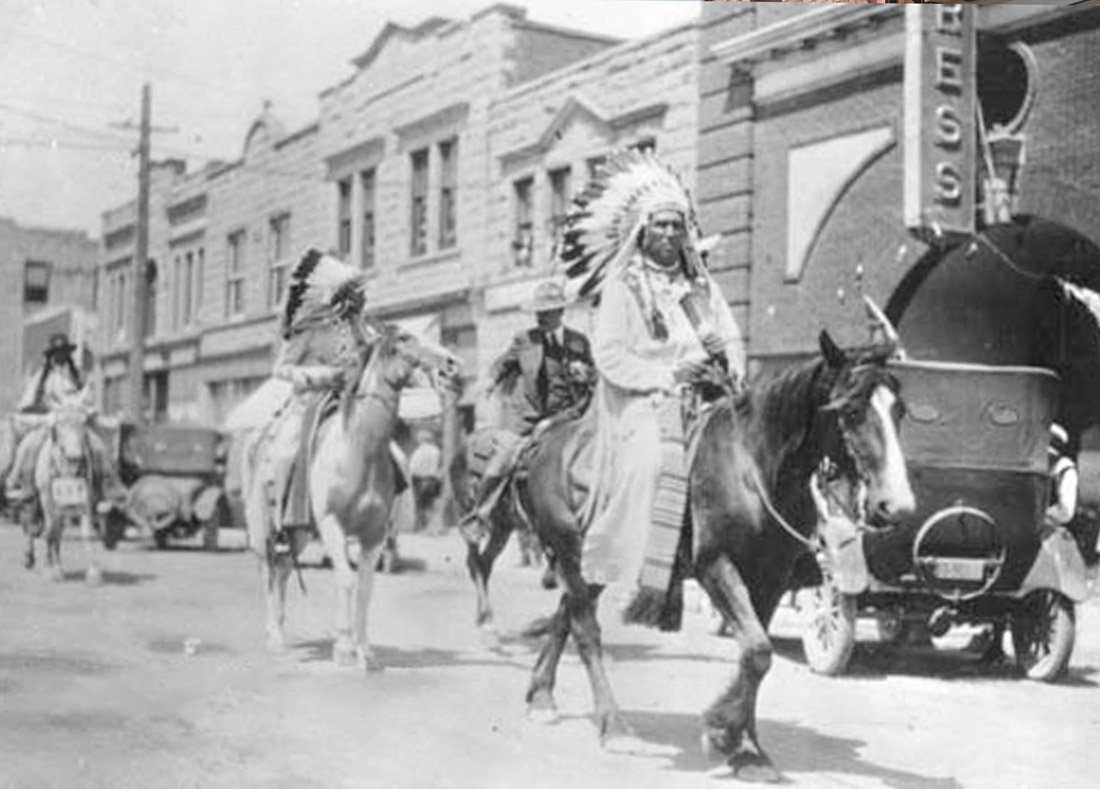
While the Empress Theatre wasn't Fort Macleod's first theatre, it was certainly the most luxurious. When T. B. Martin and J. S. Lambert dreamed up the Empress, their idea was to build a "first class theatre" that was complete with "every modern accessory." Not only did the theatre have the capacity to play silent films, but its interior was decorated in a modern style and boasted an orchestral pit. As the theatre became more successful, it grew to have enough plush chairs to seat 400, as well as Tiffany lamps for lighting.1
A well known contractor in Fort Macleod, J.S. Lambert, began construction on T. B. Martin's theatre in 1910. Martin's first act as the owner of the new two-storey theatre was to hire Fred and Mary Cutler to play music in accompaniment to silent film features. In the theatre's heyday in 1937, it played as many as two shows a night, with three features a week.
Much of the theatre's decor is from the 1920s and 40s, and much of the original fabric and ornamentation remains. Today, the wooden floors, stage, and dressing rooms downstairs have been preserved, along with the graffiti on the walls from visiting artists from as far away as New York City and Australia. "Texas Tony and his Wonder Horse, Baby Doll/The Purple Sage Riders, 1935, from Isabella, California", and "CPR Minstrels 1923" are some of the names recorded on the walls, with some contemporary artists following the historical example and leaving their own names.2
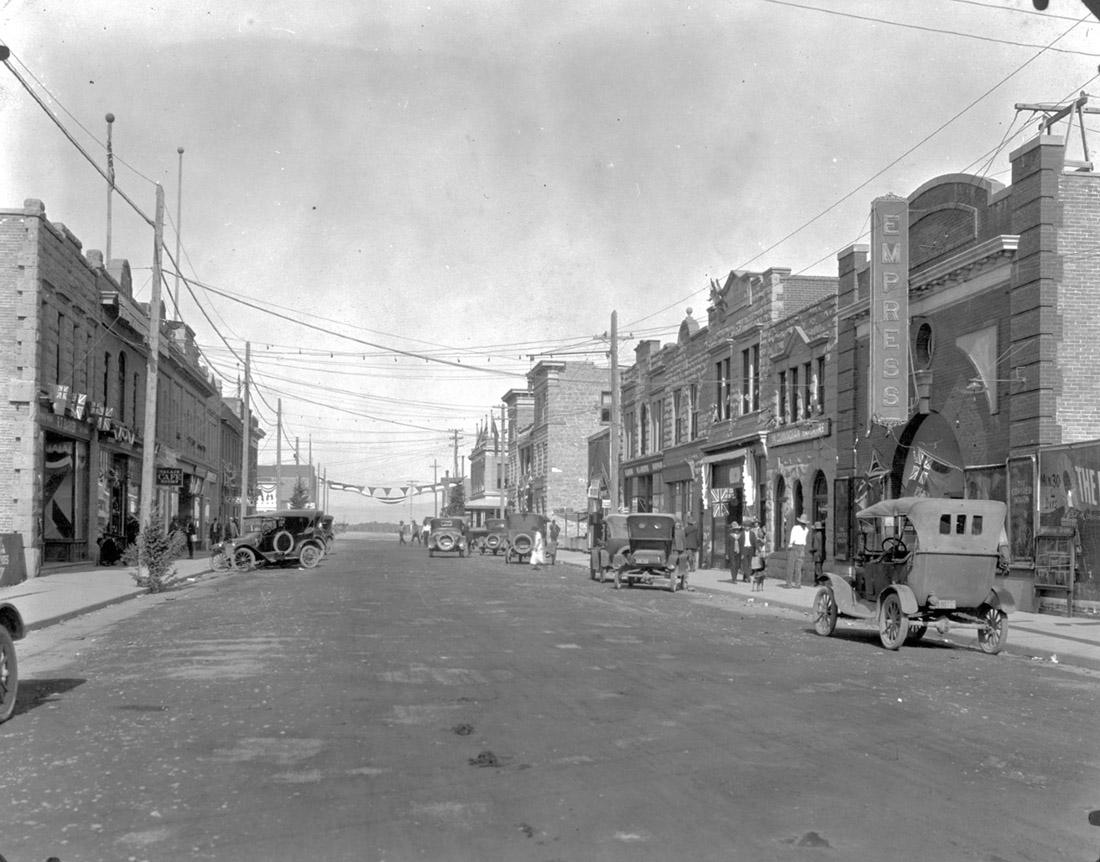
Another unique feature of the theatre that survives today comes from the Empress's second owner, Daniel Boyle, who placed a neon light installation featuring three pink and green tulips in the ceiling as a first anniversary gift to his wife. Today, Boyle is remembered not only for his heartfelt gift, but for another characteristic, "Dan Boyle had a sneeze worthy of an artillery cannon. When Dan sneezed, it came suddenly and unexpectedly and usually left anyone within a half-block area with shell shock and a hearing impediment."3
Small theatres like the Empress were once common across the prairies, although now the Empress is one of the few remaining. These institutions were a highlight of small prairie town social life, and people from all walks of life could find something on offer at the Empress that appealed to them. The vaudeville acts were popular with the young mounties, while others enjoyed lecture series, musical performances, and movies.
Today, the Empress Theatre is a historical landmark. It is open 364 days a year (the exception being Christmas Day) and operates as a movie theatre and live performance venue. It also hosts conferences, political events, theatre performances, memorials, conventions, and musical plays, while operating as a community registered charity, non-profit.
2. The Police
Fort Museum Archives FMP 81.147c
1943
Spectators watch men on horseback proceed down the street as part of the Macleod Stampede celebration. Horses were an important part of life in early Fort Macleod. The North West Mounted Police (NWMP), who first founded Fort Macleod in 1874, relied on them heavily for their patrols, and they were essential for the work of ranchers and farmers. While the fort was the first permanent settler structure in the area, a town soon grew up around the fort.
* * *
Jerry Potts, a Metis guide and translator, led the police to this spot and suggested that the island in the centre of the Old Man River would be an ideal place for a fort. The island was defensible and large enough to host all of the buildings necessary to support the force. Unfortunately, despite these qualities, the location frequently flooded when the waters of the Old Man River swelled in the spring. After a few years of enduring the floods, the decision was made to move to higher ground near to where the town is presently located.

Soon after the NWMP built the fort, they were joined by others who settled nearby to support it. One of the first merchants to set up in Fort Macleod was the already successful I. G. Baker, who was known as one of the most important traders and transporters of goods in the northwest. Baker, who was based out of Fort Benton, specialized in moving goods by bull train from Missouri River port warehouses to trading posts in Fort Macleod and Calgary. While I. G. Baker was running his trade enterprises, it fell to D. W. Davis, a former whiskey trader who turned to legitimate business, to manage the store in Fort Macleod.
Outside of fort duties, police balls were held occasionally to provide a welcome break and sense of community to the police and other locals. Everyone in the area was welcome at the balls, which were the social event of the season. In the early years, when there were few settler women, mounties would take Metis and Blackfoot women as their dates and dancing partners. Colonel Macleod himself had a tradition of taking a First Nations woman as his dance partner for the first dance of every ball as a mark of respect.1 In later years, more women arrived, and after a late night of merry-making, the men would sleep outside warmed by a bonfire, while the women spent the night in the barracks.2 The balls had the effect of bringing people together and providing both the mounties and early settlers a respite from the hardships of frontier life.
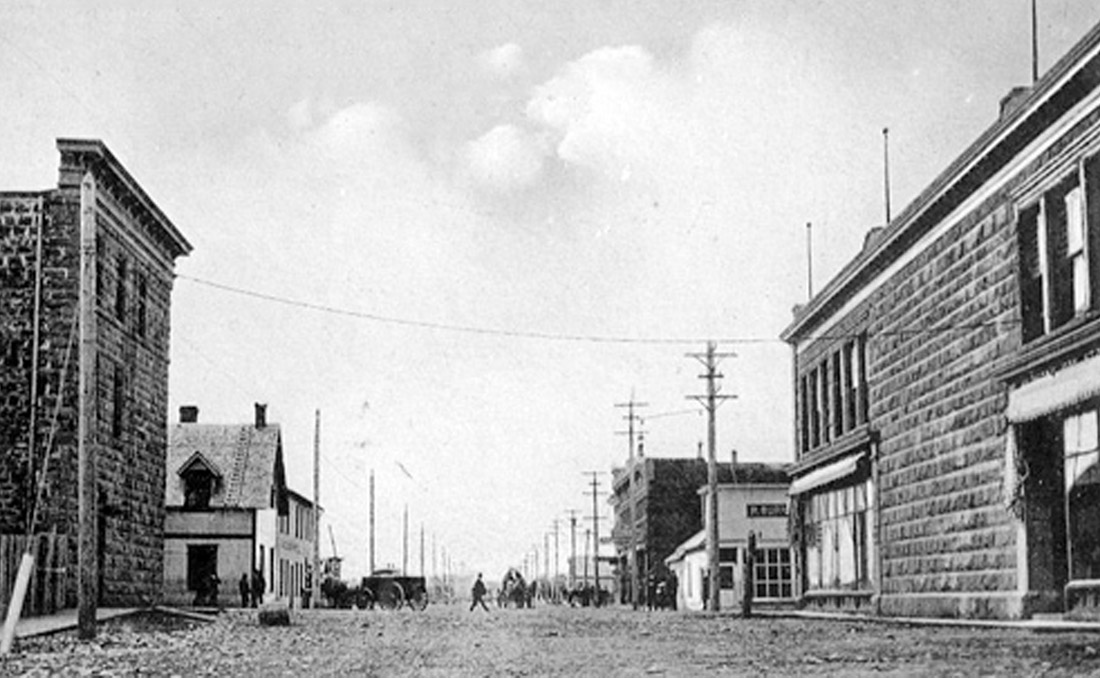
After repeated flooding of the original fort site, the decision was made to relocate about a mile up river on the south bank. As more shops, a hotel, blacksmiths, and other buildings popped up along the main street, more settlers arrived, and the town was officially incorporated in 1892. Upon incorporation, the town's name was shortened to "Macleod," as an effort to indicate growth from its police fort roots. The name Macleod remained until 1953, when it was restored to Fort Macleod in recognition of the community's history.
3. Meeting Main Street
1948
A postcard of 24th Street taken by a local photographer in 1948. The photo features the Queen’s Hotel on the left, the Canadian Bank of Commerce on the right, and several other businesses. In this photo the street is lined with cars, but before the rise of the automobile, transportation was primarily conducted by horse or oxen team.
Drivers of oxen teams were renowned not only for their ability to drive in extremely challenging terrain and conditions, but for their phenomenal grasp of curses and expletives. The Macleod Gazette described one particular driver's curses as "never microscopic or feeble, but resounding and polysyllabic."1
* * *
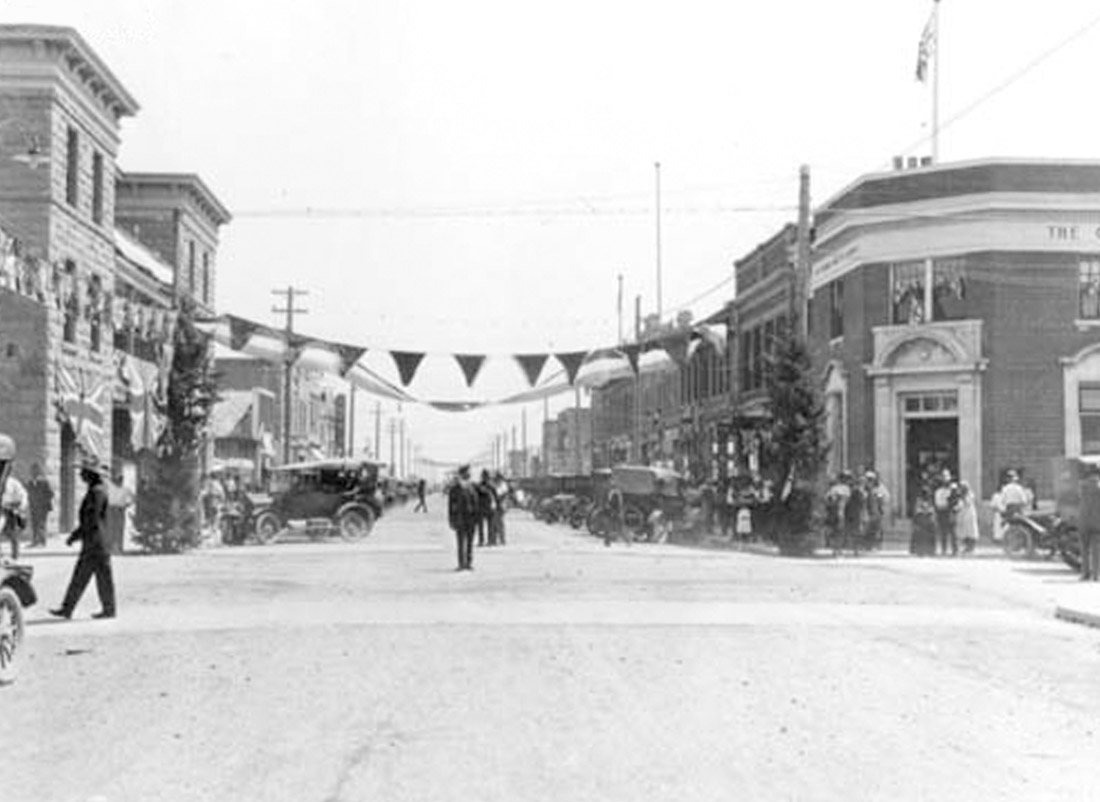
When the first non-NWMP settlers arrived in Fort Macleod, the settlement consisted of the NWMP fort on the island in the Old Man River, a small smattering of buildings on the south bank, and hundreds of kilometers of open prairie. The landscape of the foothills around Fort Macleod was an arid, semi-desert environment that was poorly suited to agriculture. The grasslands of the prairie were poorly suited for agriculture, but ideal for supporting livestock, just as they had supported the vast herds of buffalo that came before.

The increase of settlers in the area increased the number of businesses and buildings on Main Street. However, in 1906, a devastating fire destroyed the majority of the original wooden buildings, prompting the town to pass a bylaw requiring new buildings to be constructed from stone, many of which survive today. The Canadian Bank of Commerce building on the southeast corner of Main and 2nd is a prime example of Fort Macleod's heritage buildings. Originally, the Bank of Commerce occupied a building two doors down that was purchased from the Cowdry brothers. Then in 1910, this two-storey brick building was built on this site specifically for the Canadian Bank of Commerce, and signaled a period of explosive growth and optimism in Macleod. Unlike many buildings from the same era which featured glass storefronts, banks such as this one had small, elevated windows to deter theft. An example of these open glass storefronts is apparent in the McNeill-Mathews Block, which is a unique L-shaped building with storefronts on both the south (facing onto 2nd Ave.) and on the east (facing onto Main Street) of the Commerce building.
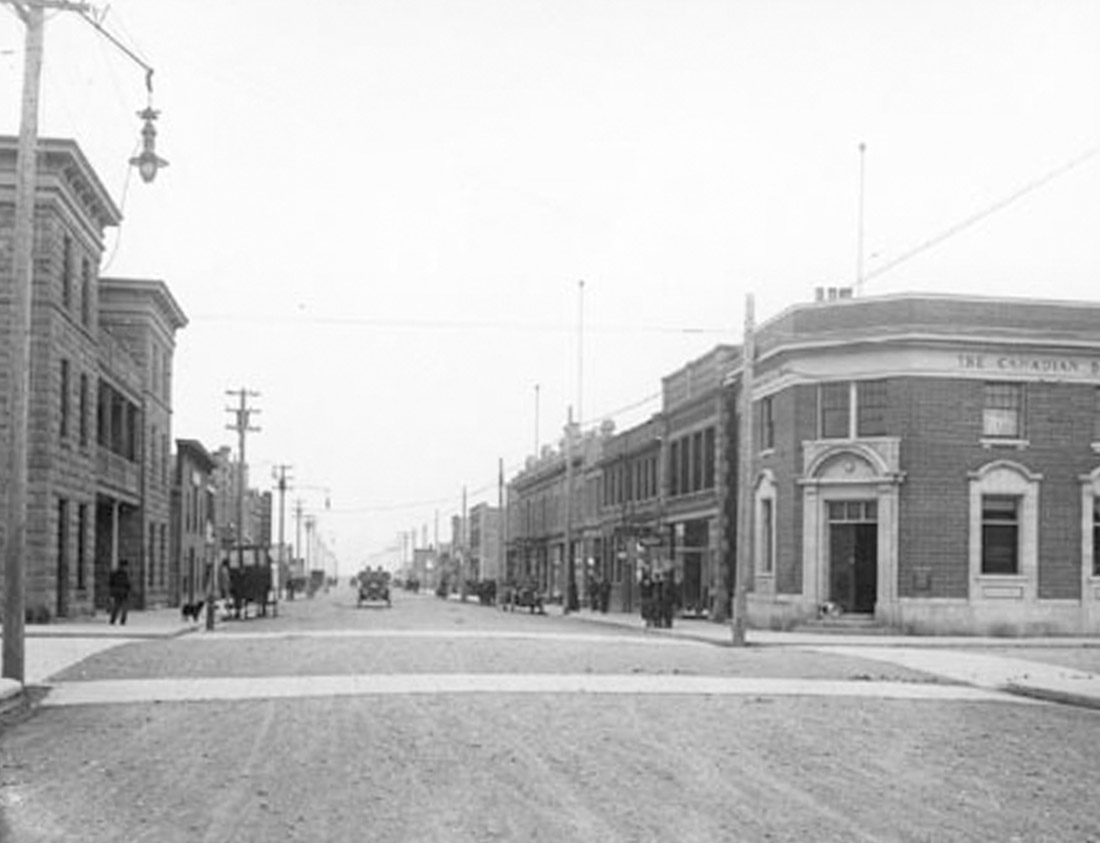
4. The Queen's Hotel
1900s
In this photo several people, a dog, and a horse-drawn carriage are on the street outside the Queen's Hotel. This hotel was once one of the finest hotels in western Canada, and today is a prominent example of turn of the century masonry. The hotel was first built as a wooden building in 1903, before being demolished and rebuilt in its current sandstone form. This was the first building in Fort Macleod to be made of sandstone, highlighting its financial and social importance in the community. T. H. Stedman, the hotel's owner, had his name inscribed into the stone masonry on the outside of the building, which is still legible today. In recent years, the hotel's saloon was featured in the film Brokeback Mountain.
* * *
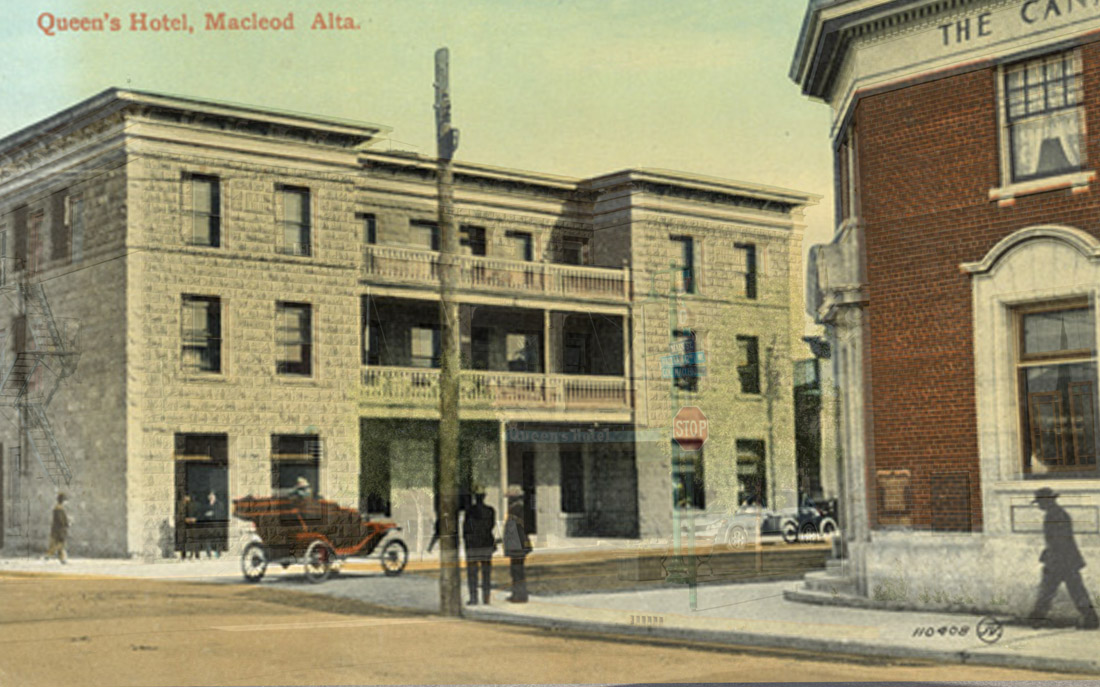
Two buildings to the right of the Queen's Hotel is the original Andrew's Hardware building, originally Renwick Hardware. It was built in 1910 to house a hardware store that operated until 1920. In 2007, a Canadian film called Passchendaele was filmed here. Paul Gross starred in and directed the film, which was inspired by his grandfather, who had fought during World War I. Andrew's Hardware served as a recruiting office in the film. The next building to the right is now Johnny's restaurant, but once housed Callie's "Pioneer Furniture Store." Callie sold furniture, but also managed an undertaking and funeral parlour in the same building. The business grew and Callie built a brick stable and wooden warehouse on his residence property to shelter the two horses and hearse for the undertaking business and to store the furniture inventory.
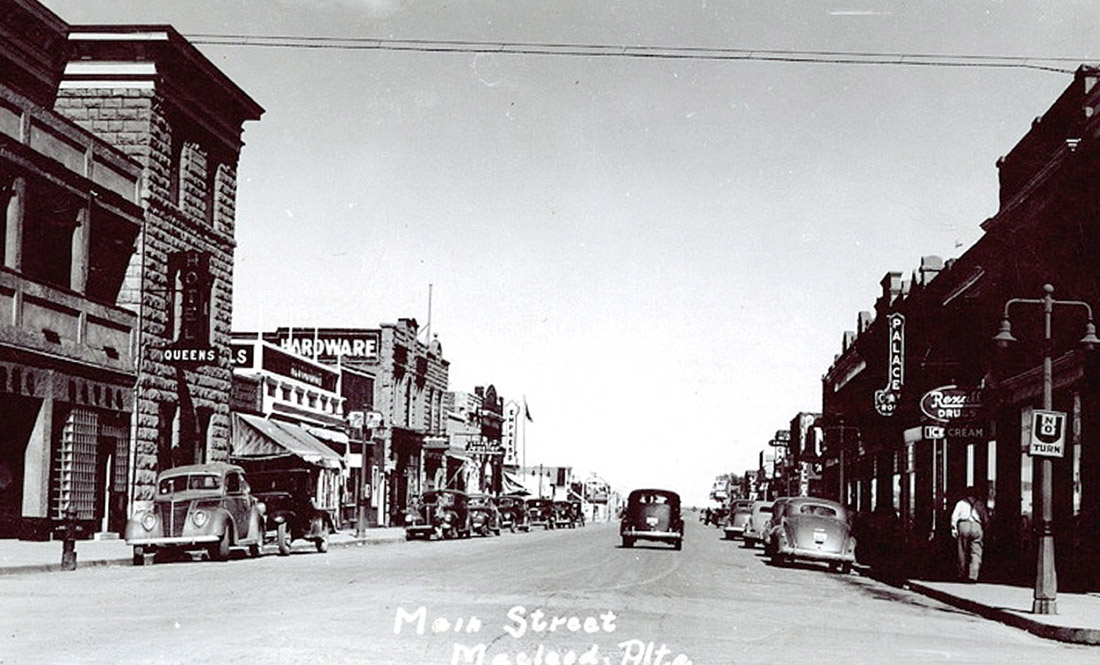
5. Communication and Transportation
Fort Museum Archives FMP 81.145.5
1940
A line of First Nations in full traditional dress lead a parade down 2nd Avenue past the Telephone Exchange Building, an arena, and a bandstand. The Telephone Exchange Building was built in 1939 as part of the improvement of Macleod's communication infrastructure, which had been established in 1899 and connected to the southern Alberta system in 1906. The unique look of the building originates from the clinker bricks used in its construction. Clinker bricks are clay bricks that were overfired, causing a distinct, uneven appearance. Since modern brick manufacturing doesn't produce clinker bricks, buildings like this are products of the past.
* * *
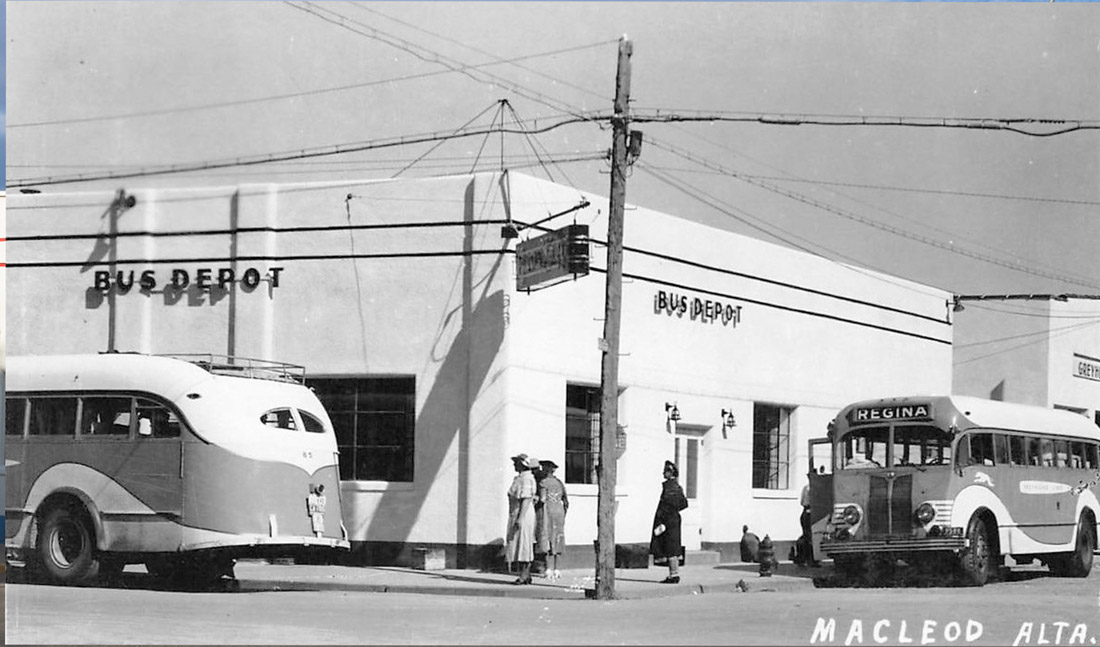
The telephone revolutionized communication, and its arrival in Fort Macleod signaled its growth and importance in the southern prairies. Initially, the telephone was installed by the Macleod Telephone Company, and was limited to the community. One could call their neighbor up for a favour, but communication with friends and family in other parts of the territory was still limited to letters. A few years later, the town was connected to the rest of the province, linking the people of Macleod to communities all over Alberta in a whole new way.
The Telephone Exchange was originally housed at the corner of 20th Street and 2nd Avenue, where it stood for 42 years before being moved to this location in 1939.
6. Macleod at War
1922
In this photo, a large crowd attends the ceremonial unveiling of the Macleod War Memorial by General Stewart in 1922. Today, there are four monuments in this square, the cenotaph stands in the front to honour the memory of fallen soldiers, the cairn in the centre was erected to celebrate the achievements of the RCMP, while the stone on the left memorializes the British Commonwealth Air Training Plan, the World War II Commonwealth Air Forces, particularly those who were trained at the nearby flight schools.
* * *

By the time World War II erupted over 20 years later, the skies had become an arena of conflict equivalent to land or sea. The British, however, were severely lacking in pilots and were poorly suited for training new ones. The weather was foggy and unpredictable, there was little land or resources to support air facilities, and their proximity to Europe put them at constant risk from enemy attack. Instead, the British looked to the Commonwealth. Canada, specifically the prairie provinces, was ideal for establishing flight training facilities. There were vast, empty swathes of flat land for runways, the weather was often clear, and far from the coast, the pilots were virtually safe from attack. All of this made Canada an attractive host for air training, but the fact that they agreed to shoulder 75% of the cost of the program, which exceeded $2 billion by 1945, sweetened the deal.1
The BCATP called for the creation of Elementary Flying Training, Service Flying Training, Air Observer, and Flight Engineer schools. Fort Macleod, Vulcan, and Penhold and other nearby communities all hosted BCATP facilities. At Fort Macleod, the airfield consisted of a RCAF station, as well as the No. 7 Service Flight School. When the school opened, Group Captain G.R. Howsam closed his address with the words, “In your sure hands, the Empire Training Plan will surge on in Macleod to an ever increasing success until victory is won and our way of life is forever secure from the foul threat of Nazi slavery.”2
The school taught advanced flying to wings standard for pilots bound for Bomber, Coastal and Transport Commands of the RAF. The only aircraft that flew out of the Fort Macleod Training School was the Avro Anson, a British twin-engined multi-role aircraft manufactured by the company Avro. Despite being produced in the mid 1930s, these planes were already obsolete for front line combat by the outbreak of World War II, and were retired as aircrew trainers. The Ansons were the mechanical heart of the BCATP and the aircraft that the majority of allied pilots practiced their skills on.
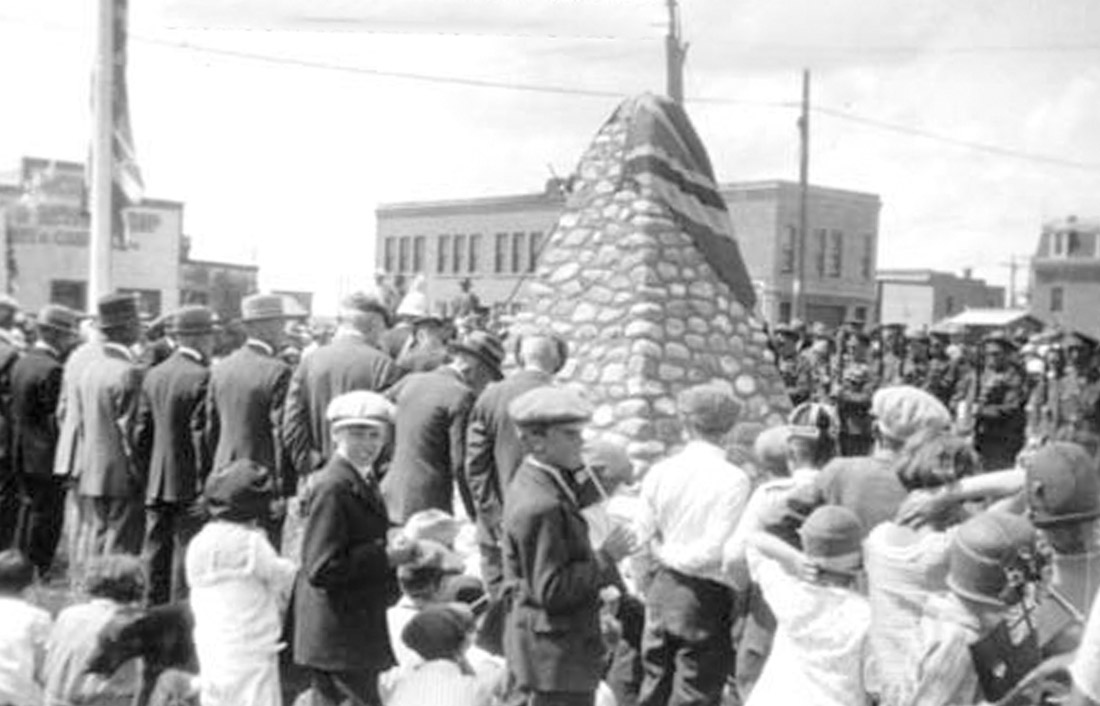
With so many novice pilots taking to the skies, accidents were inevitable. In January 1941, two Avro Ansons at Fort Macleod collided with each other 50 feet in the air. The two trainee pilots, LACs John Sully McKeown and John Boli, miraculously managed to avoid damage to any of the four propellers, and were able to do a controlled, coupled landing, with one plane landing on top of the other. Neither of the men were hurt. The bottom Anson (RCAF serial 6220), however, was damaged beyond repair and was written off after only 100 hours of total flying time.3
In November of 1944, the war was coming to a close and the demand for bomber pilots dwindled. No. 7 Service Flight Training School closed on November 17th, 1944. After the closure of the school, the station itself remained operational and hosted the No. 1 Repair Equipment and Maintenance Unit (1 REMU), which stored and repaired RCAF aircraft. Many of the RCAF's Lancasters, four-engined strategic bombers, were stored at the station for a time.
While the site of the airfield is now home to the Fort Macleod Airport and a nearby housing development, a few of the old station buildings that serviced the RCAF station and flight school still stand, although they are in poor condition. Today, the high school athletic teams are named the Flyers and the Ansons in memory of the station, and of the pilots who learned to fly there.
7. The Courthouse
Fort Museum Archives FMP 87.25.126
1921
The arrival of the North West Mounted Police brought colonial justice to the prairie. While First Nations laws and customs had governed their own communities, small numbers of dispersed settlers had lived under the lawlessness of whisky forts, Hudson's Bay jurisdiction, or their own whims. To this end, the Courthouse (then Town Office from 1971-2017) was built in 1902 to service the region's judicial needs. In the town's early years, the basement was used as a jail, and the jail cells remain there to this day. It was used as a setting to shoot a divorce hearing in the movie Brokeback Mountain. Across the street to the north is the Reaches Warehouse, the oldest building in the provincial historic area on its original foundation.
* * *

For almost a decade in the early years of settlement, justice on the frontier was dispensed almost entirely by the force. Lacking judicial structure, the NWMP had the power to not only capture criminals, but prosecute for small offences on the spot, and arrest and imprison the offenders. The cases were then turned over to Colonel Macleod, the NWMP Commissioner and the only man in the area educated in Canadian law, as well as the region's stipendiary magistrate, who would make the final ruling. For his part, Macleod had to balance his role as commissioner with the impartiality of a magistrate, all while keeping in mind the practical realities of life on the frontier.
Despite what could have been a conflict of interest, in both his role in command of the NWMP, and as magistrate, Macleod was seen as being fair and just in his decisions. Once, when an American lawyer challenged him on a nuance of the law, Macleod bluntly informed the man that law was less formal on the prairie: "What we want in this country is justice, not law."2 He was well-versed in the law from his time in the legal profession, and knew that for the people of the community, debating the often confusing minutiae of legal jargon in court was impractical, and could distract from the primary objective, that justice was delivered fairly.
In 1883, nearly 10 years after the establishment of Fort Macleod, the first lawyers arrived. Charles Courselles McCaul and Frederick WIlliam Gordon Haultain, two friends, established practices that tended to the legal needs of settlers in the communities. They also helped spearhead community initiatives such as campaigns for a school and hospital, and advocating for better administration for justice. Haultain maintained a practice in Fort Macleod for years, even after becoming the Premier of the North West Territories.3 His primary goal as Premier was to establish provincial autonomy, which, under his leadership, led to the establishment of the provinces of Alberta and Saskatchewan in 1905.
8. Union Bank and Blackfoot
ca. 1900s
The original Union Bank building stands on the northwest corner of the intersection. This is one of Fort Macleod's oldest surviving buildings and dates to 1900. The "Mansard" style roof is an unusual style of architecture for Fort Macleod, and was an intentional design that allowed large windows for bank employees living on the top floor.
* * *

The relationship between the Blackfoot and the settlers was complicated. Sometimes, rancher and Blackfoot families would work together during food shortages and the NWMP depended heavily on First Nations and Metis guides. Town merchants also looked forward to treaty payment days, when Blackfoot would come into town to make purchases. However, sometimes, there was tension. The theft of horse and cattle was common and settlers frequently pinned the blame onto the Blackfoot, even though some settlers were just as likely to steal.
Stealing horses from enemy tribes was a long-standing cultural tradition among the Blackfoot, so settlers blamed them without evidence. The Blackfoot worried about the new arrivals, despite gratitude on the part of many, including the famous chiefs Crowfoot and Red Crow, for the NWMP's role in extinguishing the illegal liquor trade. After the signing of Treaty 7, which saw the Blackfoot segregated onto reserves, the federal government failed to deliver on several of the promises made in the treaty, and distrust and disillusionment simmered on the reserves. As federal government agencies increasingly took charge over reserves and curtailed the freedoms and cultural practices of the Blackfoot, and as new settlers poured into the region, the relationship between settlers and the Blackfoot became more strained.

In 1899, the Macleod Advance wrote an editorial lamenting the poor state of the relationship between the Blackfoot and town merchants: "In former years, during treaty times the merchants of the town were not adverse to spending a few dollars for the benefit of the Indians, and to encourage them to come into town to do their trading. The merchants were in the habit of brewing large quantities of strong tea, which would be placed at some convenient spot in the store where the Indians could get at it readily. A barrel of biscuits could be left uncovered close beside the tea and the Indians would then be allowed to regale themselves to their hearts' content… Nowadays, our businessmen, in their eagerness to obtain possession of poor Loo's crisp new dollar bills, seem to have forgotten their old-time custom. This custom should not be allowed to drop. It is a great drawing card, this consideration for the comfort and pleasure of the Indians."1
Treaty days, once an occasion that flooded Fort Macleod with currency, life, and community, soon came to be considered an outdated tradition, and as the community grew, they ceased altogether.
9. Buildings and Blocks
ca. 1904 - 1910
From this spot you can see several of Macleod's commercial heritage buildings. In the photo a crowd of people gather outside the Hudson's Bay Store. The man on the right at the horse's head is Mr. Hewson, a local rancher. To his left in the Christie hat is John Cowdry, one of the founders of the Cowdry Bank. This building was built to the north of the Grier Block in 1904, but it burned down in 1973.
* * *
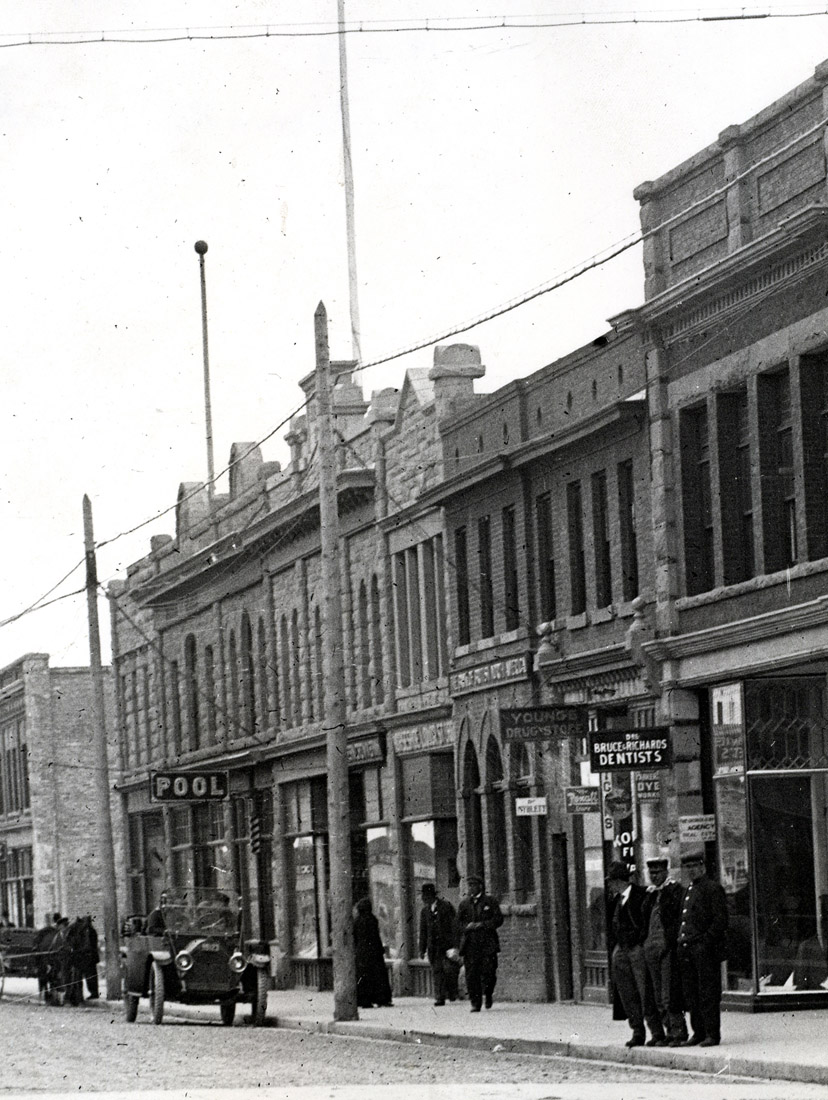
Slightly north from this spot you can catch a view of the businesses on the south side of Main Street. In between the Anderton Block, and the Cowdry Bank building is the original location of Horseshoe Liquor. This is a two-storey mixed commercial and residential building with a sandstone facade and a large storefront window. The building was constructed during Macleod's boom period from the mid-1900s to mid-1910s. Horseshoe Liquor operated out of this location until 1924, when Alberta's brief flirtation with Prohibition forced the establishment to close. After the liquor store, P Burns and Company's meat business used the space. This company supplied and delivered meat to the Mounted Police, who demanded so much meat that it was common for the delivery man to make as many as two or three trips to the fort a day.
10. Cowdry Brothers Bank
Fort Museum Archives FMP.87.36.5
1905
The Cowdry Bank stands in the centre of this photo, framed by the Horseshoe Liquor building on the left and another commercial building on the right. The bank was Fort Macleod's first financial institution, and was established by the man who would become the town's first mayor. Until the Cowdry brothers opened their bank, ranchers in the area had trouble securing loans from other banks who saw such enterprises as poor investments. The Cowdry brothers built a successful business on issuing loans that other banks wouldn't touch, and gave many settlers the finances they needed to establish themselves on the prairies.
The two-storey Edwardian brick building in front of you was constructed in 1901 to replace a wooden building that originally housed the bank. Allegedly, John Cowdry built the structure from planks he pulled up from the river two or three at a time, hauling them by foot or catching a ride from a passing wagon.1 After almost 20 years of success, the Cowdry Brothers sold this building to the Bank of Commerce, who later moved to the building on the corner.
* * *

While the ranching business could be lucrative, it was a vulnerable industry. A hard winter, a sick herd, or a cattle thief could, separately or in conjunction, easily ruin a rancher's livelihood, and most banks weren't willing to take the risk. Even if a bank was generous enough to lend a rancher a loan, the closest bank to Fort Macleod was a 300-kilometer journey away, in Helena, Montana. On one occasion, a friend of the brothers fell through some ice on the way to Helena to cash a cheque and developed frostbite, forcing him to return to Fort Macleod. Eventually, he got his cheque cashed, and his feet recovered, but it was this event that impressed upon the brothers the community's need for a bank.3
The Cowdry brothers had worked as clerks in a bank before heading to Fort Macleod, and this experience lent them the confidence they needed to start their own bank using their own funds. The Cowdry Brothers Bank was special: not only were the brothers willing to extend loans to those who had no security and very little to offer except their word, but they were also locals who understood that one run of bad luck could severely impact a rancher's finances. In these situations, the brothers were sympathetic and worked closely with the unfortunate rancher to find a payment plan that would work, often suspending interest until the person was better off.4
The bank was highly successful for nearly twenty years, after which the brothers sold it to the Bank of Commerce for a tidy profit. During his time as Fort Macleod's banker, Jack Cowdry also became its first mayor. In 1893, he won the election, saw the town through its incorporation, and helped draft its first bylaws. He also advocated for the town's name change from "Fort Macleod" to simply "Macleod." He formed a number of close friendships with many of the town's familiar figures, such as Colonels Macleod and Steele, Kamouse Taylor, and Jerry Potts.

There is one friendship, however, that inspired Cowdry's grandson to write a memoir on his life. In The Banker and the Blackfoot, J. Edward Chamberlin describes his father's close friendship with the adopted son of Chief Red Crow, a rancher named Crop Eared Wolf. The two men met shortly after Cowdry's arrival in Fort Macleod, and forged a friendship across a language barrier using broken English and sign language. Crop Eared Wolf gave Jack Cowdry the nickname "Sorreltop'', after the chestnut-coloured hair of both the man and his horse.5 Crop Eared Wolf was a very successful rancher, and became one of the Kainai's head chiefs after Red Crow's death. He saw his people through some of their most challenging years, when the reserve was threatened by both developers and the growth of the nearby community of Cardston. He never surrendered a single acre of their land.
The Cowdry Brothers Bank was one of the vital institutions that shaped the character of Fort Macleod. Without the bank, many ranchers would have failed in their efforts, which in turn would have crippled the town's economic growth.
11. The Silver Grill
1880s
This early photo of Main Street, taken in the 1880s, features the Chow Sam Restaurant on the left, wooden boardwalks lining the street, and two horse wagons on the right. After the construction of the CPR, many Chinese immigrants who came to build the railroad found themselves unemployed and looking for a place to settle. While many settled on the coast of British Columbia, a large number came to the prairies in search of wage labour. Chow Sam began his life in Fort Macleod by working at the Macleod Hotel, before eventually opening a string of successful cafes in town. Today, this spot is home to the Leather Block, and the historic Silver Grill Restaurant.
* * *
To this day, the large plate glass mirror is disfigured by what appears to be a bullet hole with several long cracks radiating out from the centre. There are two separate legends that explain the damage. In the first, told by Chow Sam himself, a brawl broke out between some townsmen, and mounties from the barracks over the affections of some of the women in town. The window was broken when either a bottle, or a chair was tossed during the skirmish. The second story is more popular, perhaps due to it's sensational nature. In this story, a man rides his horse directly into the establishment, and when the shocked bartender asked him what he wanted, the man drew his pistol and shot the neck off a bottle, "I'll take that one."1
The frame and cabinetry of the mirror was first imported from the USA and was fabricated out of solid wood. The building continues to maintain the historic features from 1910 such as the original tin ceiling, hardwood floors, solid wood spindle arch signs, and limestone exterior pillars.
When the restaurant opened, it provided confectionaries, fresh fruit, and cigars. The Rhodes Brothers were the first proprietors, but it was soon taken over by Chow Sam, who was a notable restaurateur in Fort Macleod and had already run a series of successful cafes in town. Prior to the construction of the Reach Block and the Silver Grill, Chow Sam had owned a cafe on the same site. The Silver Grill has had a number of different owners over the last century, but the name has stuck.
During the first World War, the building had a dance floor in the basement, but this was eventually closed to the public as it posed a risk in the event of fire.
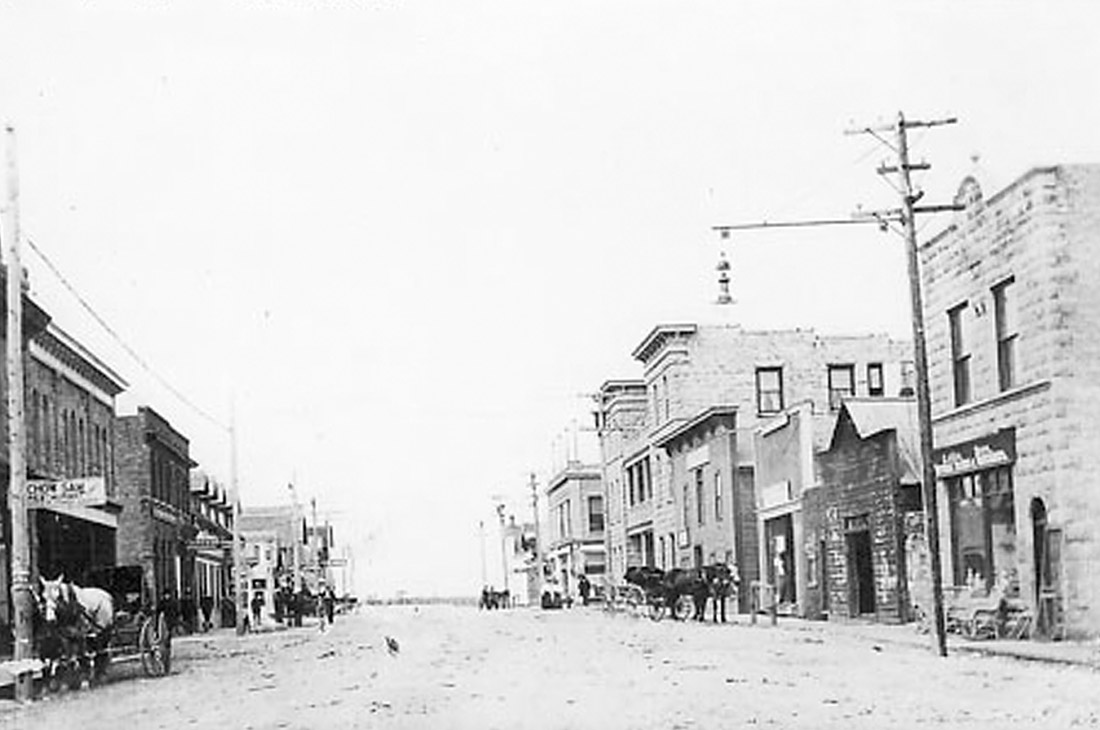
The Leather Block was built for local entrepreneur Augustus T. Leather in 1912. It is another legacy of Fort Macleod's economic boom in the early 1900s, and an example of Edwardian red brick commercial architecture.
12. The Reach Block
ca. 1900s
This photo, taken in the 1910s, features the newly built stone Reach Block and a line of men, likely the block's business proprietors. The stone Reach Block was built in 1907 to replace the wooden Reach & Co. building owned by Charles J. Reach. He operated a small business selling lime and rented storage space, but also kept groceries and general goods in stock. The wooden building was destroyed in the 1906 fire, and Reach lost both the building and his stock. Acting quickly, he set up shop in the wooden warehouse behind the building, which survived the fire, and still stands today.
* * *
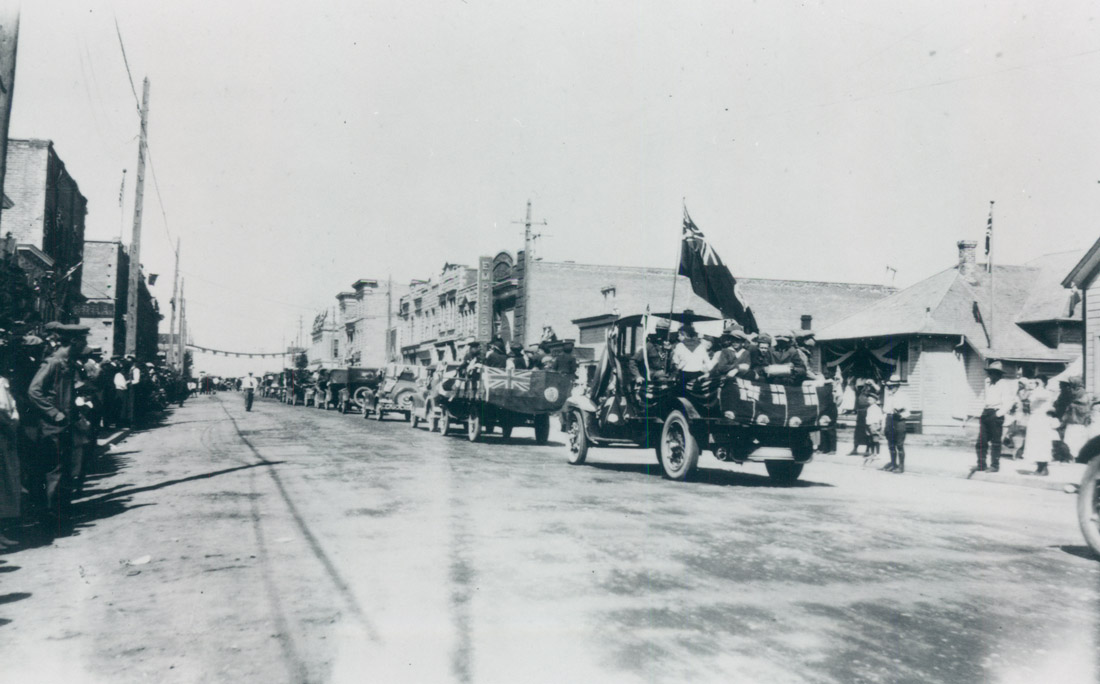
There is one early Fort Macleod character associated with the Reach Block. Dewdney spent his life between the Blackfoot and Peigan reserves, and appears in stories alongside Fort Macleod old timers such as mayor and banker Jack Cowdry and former mountie R. H. Maunsell. He was known around town for his willingness to work any job that would pay, whether in money, or in bread and old clothes. One account recalls him walking down the street in a tall silk hat and a frock coat with tails. Some recall his love of women's hats, and that he would wear several at the same time, one stacked atop the other. His winter attire consisted of a long blue coat tied at the waist with a red sash, topped with a long, tasselled toque. When not completing odd jobs, Dewdney would sit in the doorway of the Reach Store, refusing to move for customers and pedestrians. People became accustomed to stepping around him when entering the store.1
13. The Macleod Gazette
Fort Museum Archives FMP 80.6.1
1890
In this photo, R. K. Kennefick stands outside his store, Kennefick's Livery and Stable, while holding his favourite horse, Richard K. When Kennefick arrived in Fort Macleod, he became the first commercial blacksmith to settle in the Northwest Territories. The wooden building in this photo was Kennefick's first livery, but it was destroyed by the 1906 fire, and the two-storey brick building on this spot today was built to replace it. In 1925, the Macleod Gazette moved into this location, and the GAZETTE sign is still visible on the side of the structure. The Macleod Gazette published its first issue in 1882, and although it was not the first newspaper in the territories, it is now the oldest existing paper. The paper has also won numerous awards as the best newspaper with its circulation size in Canada, as well as having the best editorial and best local sports pages.
* * *
Editorials were often written by the paper's editor and co-founder, C. E. D. Wood, and gave him a chance to air his strong opinions on local settlers, national events, and local issues. In one issue, Wood wrote an incensed passage about Duncan McEachern, a local rancher and the chief veterinary inspector in Canada, a man whom he had disagreements with: "[McEachern is] a blustering and egotistical little man… he evidently finds it impossible to open his mouth without rushing into all sorts of extravagant and untrue statements… The swelling of his head has rendered him oblivious to everything, except his own self-importance."1
Once, Wood wrote a short editorial for the column devoted to good-humoured fictional stories. The story went that a Colonel asked his companions how they would feel about a bank opening in town. The men in turn responded that they would be happy to rob such an institution:
"Well, then kurnel, there ain't no need of guessin what I'd do. I'd be right on hand with two guns, and them guns would be ready fur shootin, and I'd lay the bar'ls on the counter and say:
"'Good mornin, Kurnel Taylor.' "'Good mornin, Pete Green.' "'Is this bank open fur bizness?' "She are.' "Then hand me over them $5000 as quick as ye kin handle money, fur my fingers hev got the cramps and will be pullin on these triggers if ye wait to catch your breath!"
The story ran alongside an ad for the Cowdy Brothers Bank, an ad that had appeared in the paper every week since opening.3
Despite Wood's often humorous take on frontier life, he took a strong stance on current issues. One topic of the day that he firmly supported was Blackfoot assimilation.4 Some settlers, like Wood, hoped to see the Blackfoot fully assimilated into broader Canadian society, while others felt that these efforts were deeply damaging to the Blackfoot, and that assimilation either wasn't the correct course or was being approached the wrong way.
On a national level, many people were concerned by the unstable federal government, which had changed four times in five years and was rocked by tenuous party coalitions and religious divides. In response to these events, and Wood's opinionated takes on them, Jack Cowdry and Piikani Chief Big Swan started a satirical newspaper as a counterpoint to the Gazette.
They titled their paper The Outlaw. It ran for six weeks, between May 19th and June 30th, 1886, with one issue every week leading up to the federal election. The Outlaw was created as a satirical, bipartisan paper which criticized both the conservatives and the liberals alike. Its intent, as stated by the paper, was to "expose the shams and frauds and rampant hypocrisies that surround us on every side."5
The Outlaw reflected the fear held by Fort Macleod settlers that the interests of the Blackfoot and the local settlers would be buried in the haste to settle the west. Many in the west felt that Ottawa and its policies had left behind those on the frontier. Frank Oliver was elected to replace Clifford Sifton as Minister of the Interior, and focused on increasingly racist immigration policies, rather than the class-based focus on farmers preferred by Sifton. Western alienation, which was felt as early as the 1880s, remains a political topic debated by some Albertans today.
In The Outlaw's final issue, two weeks before the election, the paper published its own obituary: "DIED: At Scott's Coulee, Alberta at 4:00 PM Tuesday June 30, 1896. The Outlaw. Deeply Regretted."6
14. The Virtue Building
Fort Museum Archives FMP 87.44.1
ca. 1890s
This black and white postcard by Rumsey & Co., of Toronto looks west down 24th Street in the 1910s. The wooden Virtue building stands third from the left with the Meat Market on it's right side, followed by the Leather Block. The Reach Block is visible further up the street.
* * *

The building was sold again in 1919 to a new owner, William Whitworth, who continued to use it as an ice cream parlour and general store. It was Whitworth who added the false front facade. These fixtures were popular this period for the grand appearance they gave to an otherwise modest wooden building.
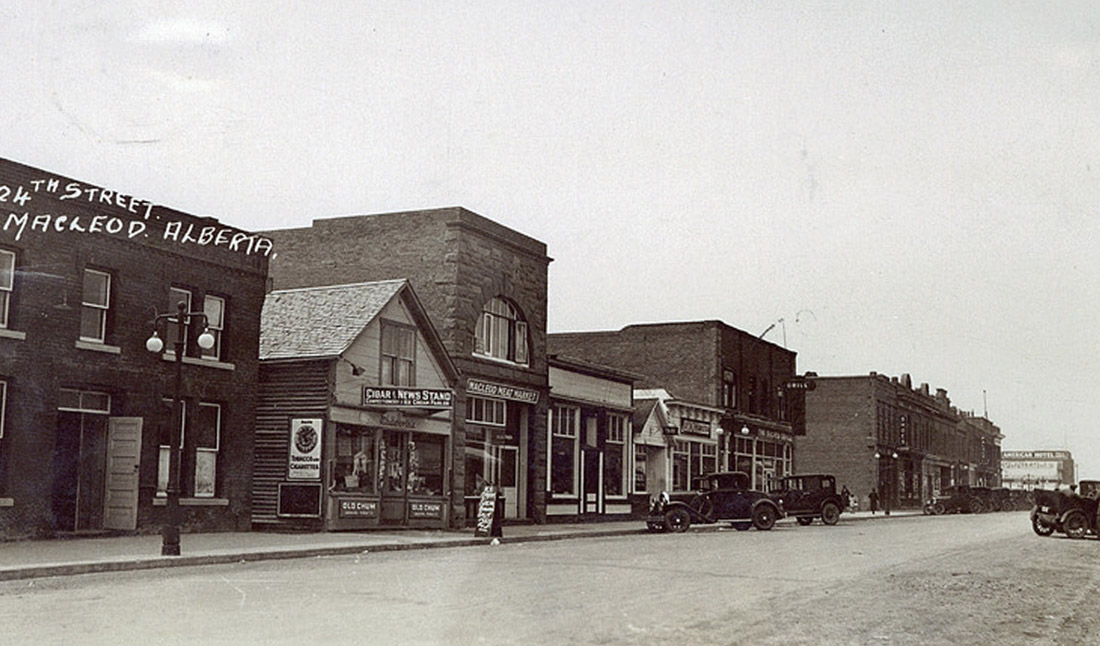
The Meat Market Building is another important heritage landmark on Main Street. Built in 1910, this two-storey sandstone and brick building features a large semi-circular window on the second floor, and a large ghost sign for "George H. Scougall Real Estate" on the west side of the second storey. The Meat Market occupied the bottom portion of the store, with the real estate office on the second floor. Over its life, the building also held a bakery, and then the Main Street Renewal Program, and the Main Street Office.
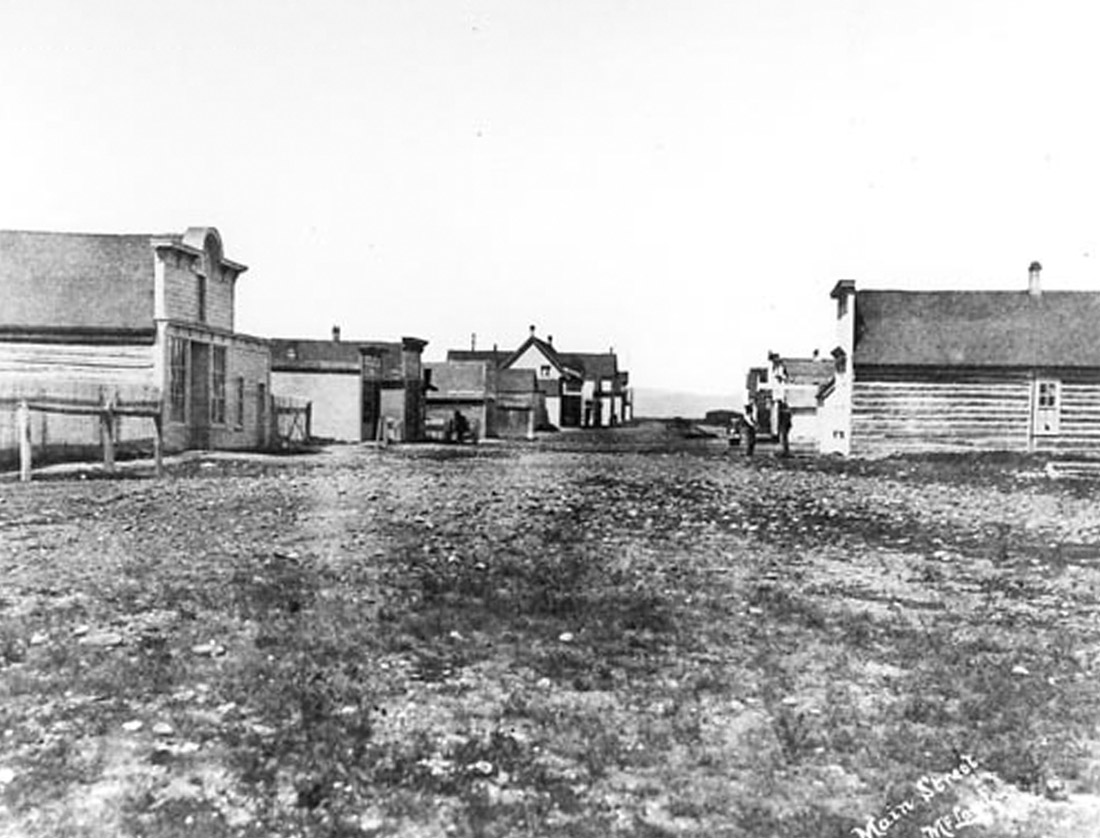
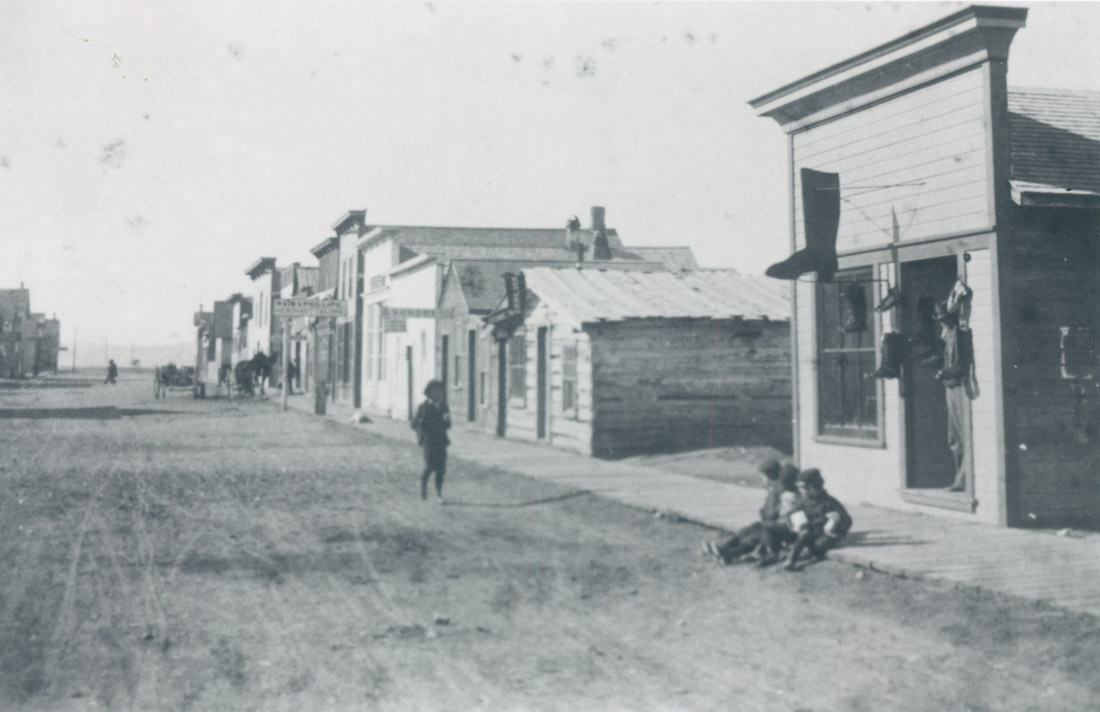
15. Chow Sam's Boarding House
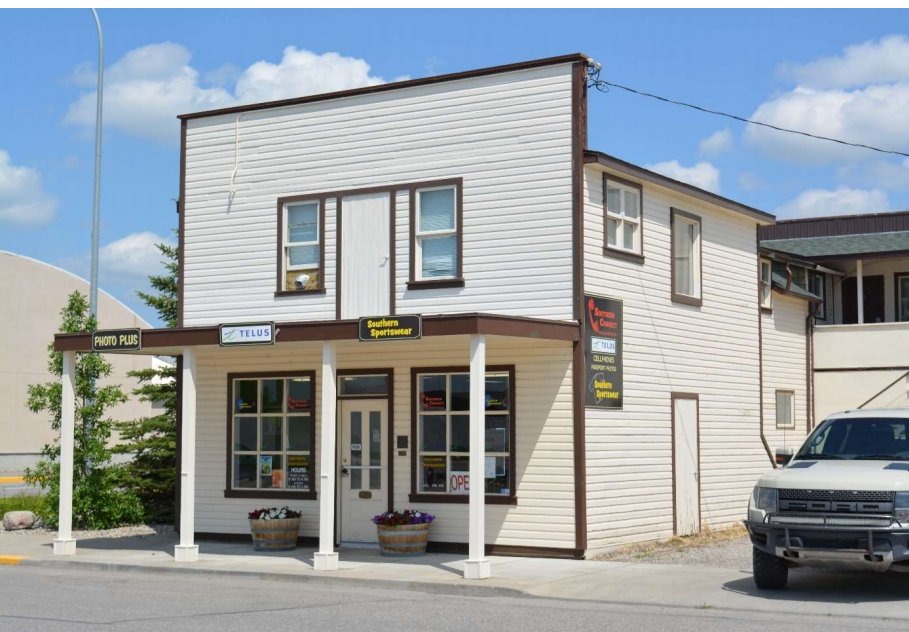
Fort Macleod Heritage Register
ca. 2000s
Here in the heart of what was once Macleod's Chinatown is Chow Sam's Boarding House. This 1.5 storey building was built as a mixed-use commercial/residential building with a long rectangular wooden frame building with a boomtown facade and a front gabled roof. Due to institutionalized racism in many Canadian settlements in the late 19th and early 20th centuries, many Chinese settlers were restricted in their places of work and choice of residence. Many of the bachelor men, or those who left behind families to work the CPR construction found themselves struggling to find work. Many of them ended up living in boarding house's such as Chow Sam's, which were close to their places of employment. This concentration of Chinese immigrants living and working in the same area led to the growth of Chinatowns as merchants set up shop to support the community. Macleod's Chinatown was centred around 3rd Avenue and 25th street, and Chow Sam's boarding house is the only remaining building from this community.
* * *
Those who survived the ordeal were left in the lurch when construction concluded. Many immigrants with varying degrees of fluency in English faced the daunting task of finding employment in communities that were often unwelcoming or suspicious of the new arrivals. Some were able to find work in mines, or as labourers or domestic servants. Some, like Chow Sam, opened restaurants or cafes. Many others found work by opening laundries.
A small Chinese community set down roots in Fort Macleod following the end of the CPR construction. Quon Sang Lung laundry is a classic example of the Chinese laundries that sprinkled towns in the Canadian west. It was built in 1907, between 25th and 24th Street, and stood as the oldest remaining Chinese laundry in Alberta for decades. However, despite its historical value, by 2014 the building was in danger of collapse and was ruled structurally unsafe, and it was torn down. Fortunately, the age and value of the building led Alberta Culture and Tourism to team up with the University of Calgary and digitally preserve the laundry building in an accurate 360 degree form before it was demolished. While Chinese businessmen like Chow Sam and Quon Sang Lung doubtlessly encountered prejudice, as evidenced by a bylaw that specifically stated the laundries on 24th Street had to pay a higher licensing fee than laundries elsewhere, they also filled a valuable role in the community.1 Places like the Macleod Hotel depended on laundries for their clean linens, as did other hotels, boarding houses, or restaurants in the town, and these business connections helped nurture community. Chow Sam also became a friend to John Cowdry and Fred Haultain, both leaders in the community. Haultain even became the godfather to Chow Sam's daughter Kathleen.2 While Fort Macleod's Chinatown is all but gone today, the Chinese laundries were another vital link in the chain of interconnected businesses that held the community together.
16. The Catholic Church
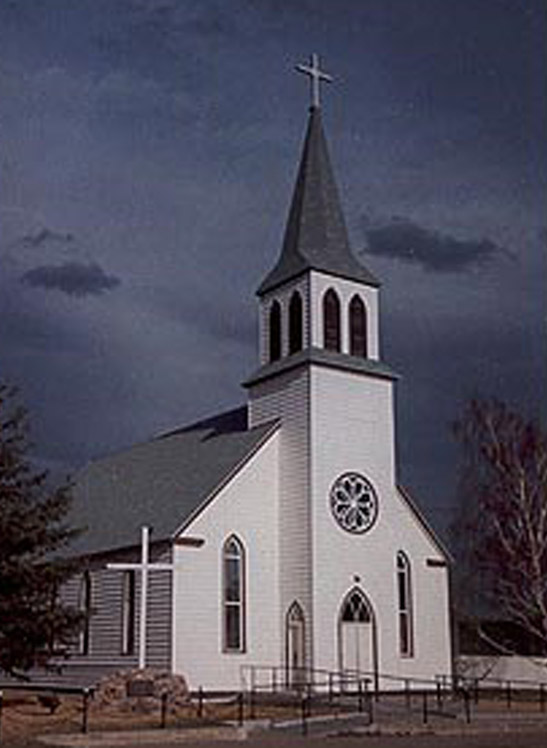
Fort Macleod Heritage Register
While this Catholic Church wasn't built until 1898, there had been a steady Catholic presence around Fort Macleod for several years. Catholic Missionary Father Scollen had visited the region twice before the arrival of the NWMP and again after their arrival. When a Bishop visited the Fort in 1876, he named it as the missionary's centre in the south. A small chapel was built on the south bank of the Old Man River in 1884 to serve the mission. Mass was held at the mission chapel for several years until the Holy Cross Church was built. In 1913, Bishop Legal estimated the town's catholics to number around 600.1
* * *
The Holy Cross Catholic Church was first planned near the original fort site, but construction was completed at its current location on the south side of the river in 1898. While the exterior of the church maintains the majority of the original design elements, the interior of the church has been subject to several alterations. Early on, the interior was completely covered with canvas depicting biblical scenes that had been painted by a young priest. Later, another priest painted over the scenes, rendering the entire canvas sky blue. The canvas was eventually taken down. The altar and sanctuary walls are constructed of wood, in contrast to similar churches of the same period which generally used marble.
There is a special stained-glass window in the back room dedicated to Father Lacombe, which was made for the church by the N.T. Lyon Company of Toronto in 1920. In addition to Lacombe's legacy in the province, he also spent time at the Peigan Reserve and helped build the rectory for the Holy Cross Church. Due to Fort Macleod's role as the missionary centre of the surrounding area, priests from the Fort Macleod church were often lent out to other parishes. The Catholic churches which are now present in the area are branches of the Fort Macleod church.
The Catholic population of the town never grew as large as some predicted. The church sponsored its own separate school district from 1888 to 1938, when it closed due to the decrease in the Catholic population. Since its establishment, the Holy Cross Catholic Church has symbolised the important contribution of the Catholic Church to Fort Macleod’s development.
Endnotes
1. Empress to Queens
1. "Empress Theatre - Fort Macleod." Heritage Resources Management Information System, Alberta Heritage Register, 2021. Website.
2. "Empress Theatre - Fort Macleod, Alberta," Crown of the Continent, 2021. Website.
3. "Extensive info on Main Street Buildings with highlights, May 2018." PDF.
2. The Police
1. J. Edward Chamberlin, The Banker and the Blackfoot - A memoir of my grandfather in chinook country" (Toronto: Alfred A. Knopf, 2016), 238.
2. Fort Macleod History Book Committee, Fort Macleod - Our Colourful Past (Fort Macleod: Friesen Printers, 1977), 22.
3. Meeting Main Street
1. Chamberlin, The Banker and the Blackfoot, 31.
2. "Extensive info on Main Street Buildings with highlights," May 2018. PDF
5. Communication and Transportation
1. Chamberlin, 188 - 189.
6. Macleod at War
1. Dave O'Malley with Todd Lemieux, "The Ghosts of Southern Alberta", Vintage Wings of Canada, 2019. Online.
2. "BCATP Station Fort Macleod - No. 7 Service Flying Training School", Old Bomber Command Museum, 1995 - 2019. Online.
3. Dave O'Malley and Todd Lemieux, "The Ghosts of Southern Alberta."
7. The Courthouse
1. Fort Macleod Provincial Historic Area Society, "Courthouse, 1902 - 236 23rd Street" in Walking/Driving Tour of Fort Macleod's Historic Downtown and Residential Area Brochure, 16.
2. Fort Macleod - Our Colourful Past, 29.
3. Ibid, 30.
8. Union Bank and Blackfoot
1. Fort Macleod - Our Colourful History, 14.
10. Cowdry Brothers Bank
1. Chamberlin, The Banker and the Blackfoot, 198.
2. Chamberlin, 25 - 26.
3. Chamberlin, 26.
4. Chamberlin, 62 - 63.
5. Chamberlin, 2.
11. The Silver Grill
1. "Extensive Info on Main Street Buildings with highlights, May 2018." PDF.
12. The Reach Block
1. "Extensive info on Main Street buildings with highlights, May 2018." PDF.
13. The Macleod Gazette
1. Chamberlin, The Banker and the Blackfoot, 165.
2. Chamberlin, 38.
3. Chamberlin, 165 - 166.
4. Chamberlin, 256.
5. Chamberlin, 257.
6. Chamberlin, 263
15. Chow Sam's Boarding House
1. "Quon Sang Lung's Laundry Shop," University of Calgary, 2017. Online.
2. Chamblin, The Banker and the Blackfoot, 45.
16. The Catholic Church
1. Fort Macleod - Our colourful history, 60.
Bibliography
Halliday, Hugh A. "Western Air Command: Air Force, Part 30, Legion Magazine, Dec. 19 2018. https://legionmagazine.com/en/2008/12/western-air-command/
Halliday, Hugh A. "Winding Down Western Air Command: Air Force, Part 32," Legion Magazine, April 25, 2009. https://legionmagazine.com/en/2009/04/winding-down-western-air-command-air-force-part-32/
Horsfield, Margaret and Kennedy, Ian. Tofino and Clayoquot Sound: A History. Madeira Park: Harbour Publishing, 2014.
Stofer, Eric. R.C.A.F Station Ucluelet B.C. (Recollections). Victoria, BC: Self-Published by Eric Stofer, 1995.





